October 2025 News
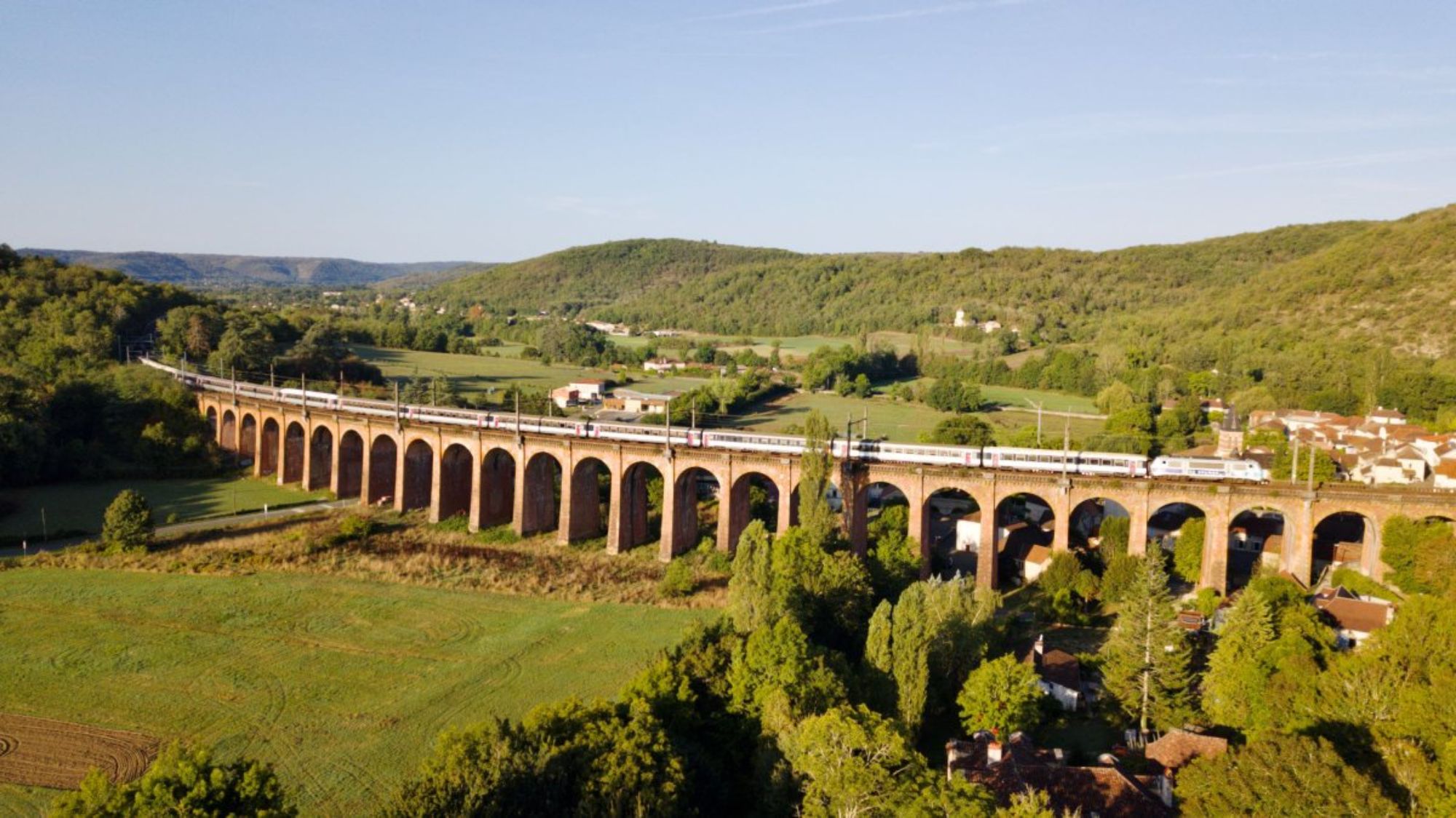
BB 26001, introduced in April 1988, crosses Calamane viaduct on 6 April with IC 3644 07.18 Toulouse – Paris Austerlitz. This train currently runs on Saturdays only due to the seven-month weekday engineering blockade for track relaying between Les Aubrais and Boisseaux (37km). On Sundays there is an 07.54 Cahors – Paris, but on weekdays passengers have to be up early for an 04.09 departure from Cahors, the last train to reach Austerlitz (09.55) before the blockade starts at 09.30. Southbound, there are weekday departures from Austerlitz for Toulouse at 06.28 and 08.24, then nothing until the 16.53 to Brive and the 17.13 to Cahors. Lengthy alternatives are available for POLT travellers by Paris – Toulouse TGVs from Montparnasse changing at Montauban or Poitiers.
The 10.27 Toulouse – Paris Austerlitz would normally arrive at Les Aubrais before the blockade is lifted at 17.30. Rather than defer the start by an hour-or-so, the schedule has been eased to give an 18.38 arrival at Austerlitz. Seen below crossing the River Lot at Cahors on 25 August, after arrival at Cahors at 12.20 it will wait eight minutes and depart at 12.28, and then spend the best part of an hour ambling the 64km up to Souillac.
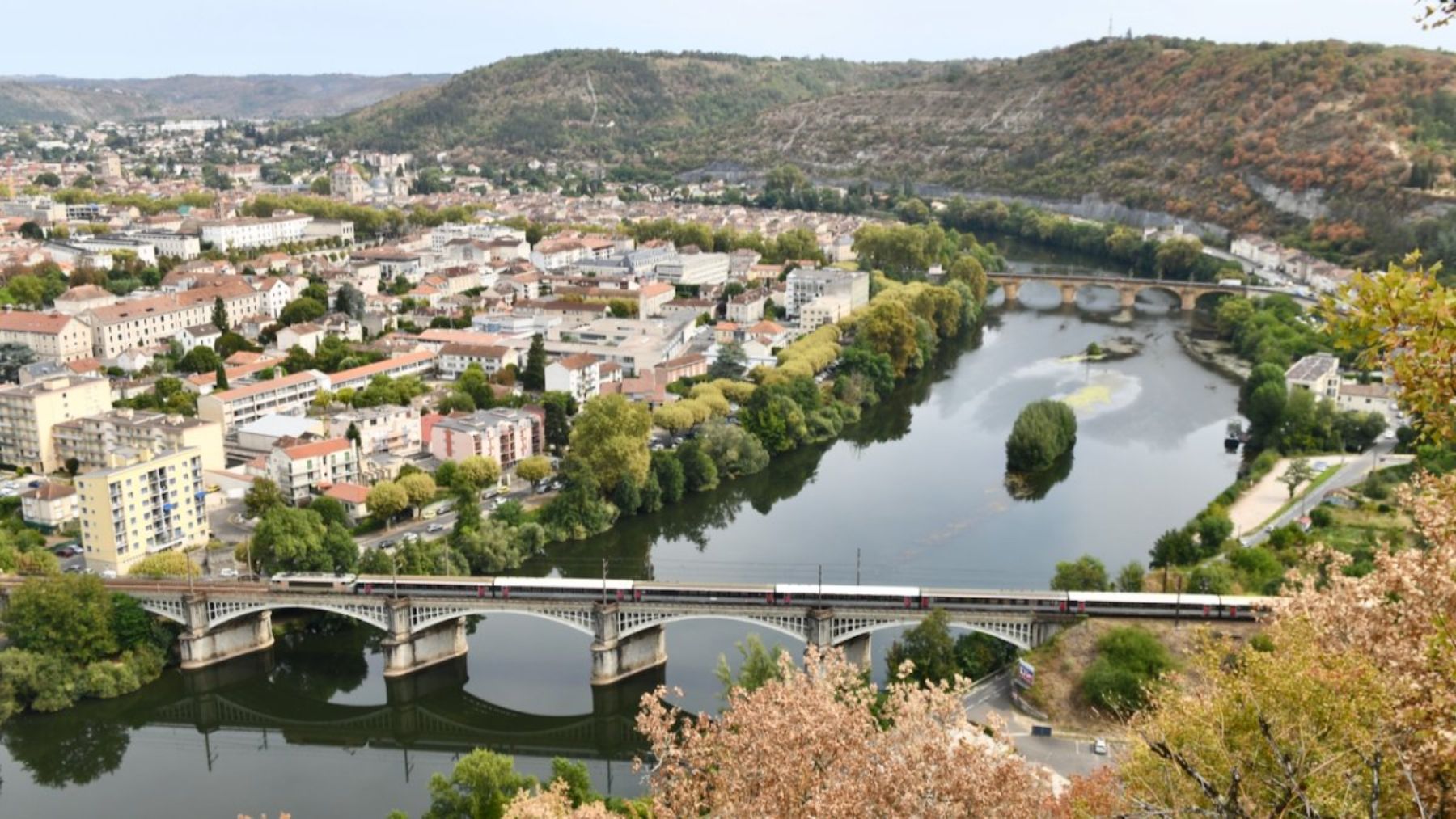
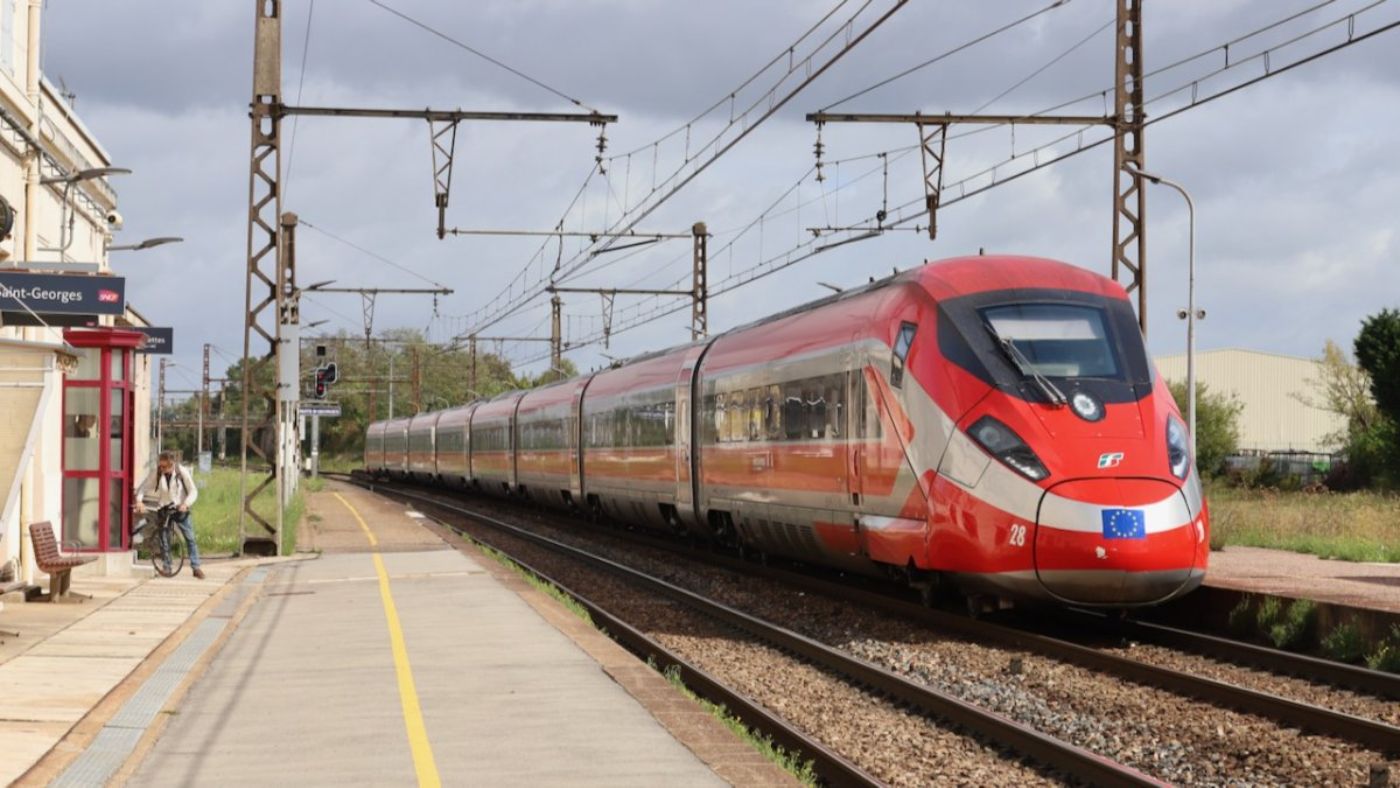
Overnight theft of cables near Montchanin forced the closure of LGV Sud-Est on 12 September, resulting in diversion of many high-speed services onto the classic line via Montbard and Dijon, rejoining LGV Sud-Est just south of Mâcon. Disruption was extensive and many services incurred significant delays or were cancelled. Above. Frecciarossa 1000 No 28 is seen passing Nuits-Saint-George working delayed Train 6647 Paris Gare de Lyon to Lyon Perrache. Photo: David Thirlwall.
Virgin: Channel Tunnel ‘funding and trains secured’
VTE said that its rolling stock and associated financing agreements would be finalised by 31 October, the date ORR is expected to announce its decision on depot access. Investment is estimated at £700 million, split between the operator and an asset-holding company. Virgin Group will retain 50% of the operator, with the other half owned by two unnamed partners.
There was surprise at VTE’s choice of the seven-car single-deck Avelia Stream trains, which at 200m are half the length of Eurostar’s 16-car Siemens Velaros. Alstom will build a 300km/h version of the Stream, which is currently limited to 250km/h. In a revision of VTE’s bid for access to Temple Mills, it appears that 200m-long trains have been chosen to minimise the maintenance and siding space required, enabling two Virgin rakes to be serviced on track normally occupied by a single Eurostar set. In addition, three tracks sought for daytime storage are now only seen as necessary when Tunnel services are disrupted.
While these changes may favour Virgin’s bid, they come at the cost of lower capacity. The 12 trains will have to be worked hard to achieve the planned offer of 20 daily A/R from London: 13 to Paris and seven to Brussels, of which three will be extended to Amsterdam. VTE said the full timetable would be in operation six months after initial launch in 2030. Image: © VTE Holdings.
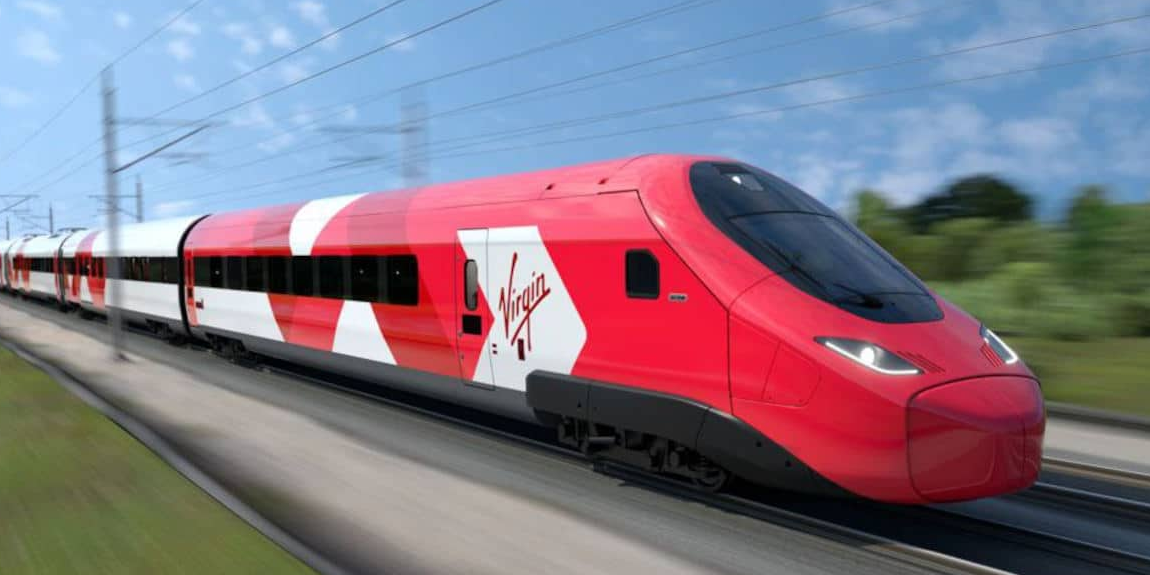
Gemini/Uber. Also awaiting the ORR’s decision on Temple Mills, Gemini Trains announced on 8 September that its Channel Tunnel offer will be launched under the Uber brand as a result of the partnership between the two companies agreed in May. Chief Executive Adrian Quine gave more details of his plans in an interview with London’s Metro. Services would start from Stratford International rather than St Pancras. Originally intended as an international stop but never used as such, Stratford’s security infrastructure and easy accessibility “would give passengers the same experience you find on Eurostar trains from St Pancras, without the chaos of central London”, he said. Ebbsfleet would also be re-established as an international ‘parkway’ station to serve Kent.
The company plans to launch services to Paris, Lille and Brussels in 2029, and then extend to Kôln as a gateway to Germany and eastern Europe. A fleet of 10 unspecified trains would be designed to bring “a bit of glamour back to rail travel”. Short turnround times would maximise utilisation. Regarding access to Temple Mills depot, Quine said: “there is a clear need for a second depot…the government needs to get serious about investing in rail infrastructure if it wants competitive fares”. The partnership would allow international booking on Uber’s app, making it possible to shift unsold seats at the last minute.
Fréthun. The maires of Calais and Boulogne-sur-Mer have stepped up pressure on Eurostar to resume service at Calais-Fréthun, where cross-Channel trains ceased to stop in 2020. “I don’t understand: we built a high-speed station…for Eurostar and now they won't stop there” said the maire of Calais, Natacha Bouchart, “this damages the economic prospects and attractiveness of the Côte d’Opale”. She pointed out that Eurostar is majority-owned by SNCF and the French State, and she was anxious to take up the subject with SNCF’s incoming PDG, yet to be appointed. Diccon Spain, deputy leader of Ashford’s Labour Group, also weighed in: “… a single organisation should not be able to override the economic and social interests of our two nations” he said, in support of restoring Eurostar service at Ashford International.
Tunnel regulatory agreements. As reported in Railway Gazette International, the UK and France have signed the last of four agreements to harmonise technical and safety rules and establish long-term governance for the Channel Tunnel following UK departure from the EU. The agreements provide train operators with certainty regarding the rules that apply, whilst reducing administrative burdens and costs.
Following Brexit, the UK and France negotiated a series of bilateral agreements to ensure continuation of services through the Tunnel: mutual recognition of train operator licences, driver certification and safety certification. The fourth covers safety, interoperability and accident investigation, providing consistent rules on both sides of the frontier inside the Tunnel, meeting France’s obligations to implement the EU’s Fourth Railway Package and with equivalent UK provisions. ORR will become responsible for supervising rail safety in the UK section of the Tunnel, a role currently held by the Intergovernmental Commission. France’s safety authority EPSF replaced the IGC for supervision of the French section in 2021.
Train operators will be issued with a single safety certificate by one of the two authorities, which in the UK will be valid as far as Ashford International for passenger services or Dollands Moor for freight, and in France to the station and yard at Calais-Fréthun. This avoids the need for operators to have multiple safety certificates to cross the border and is expected to particularly benefit freight operators seeking to reach the first point where they can hand trains over to a domestic operator.
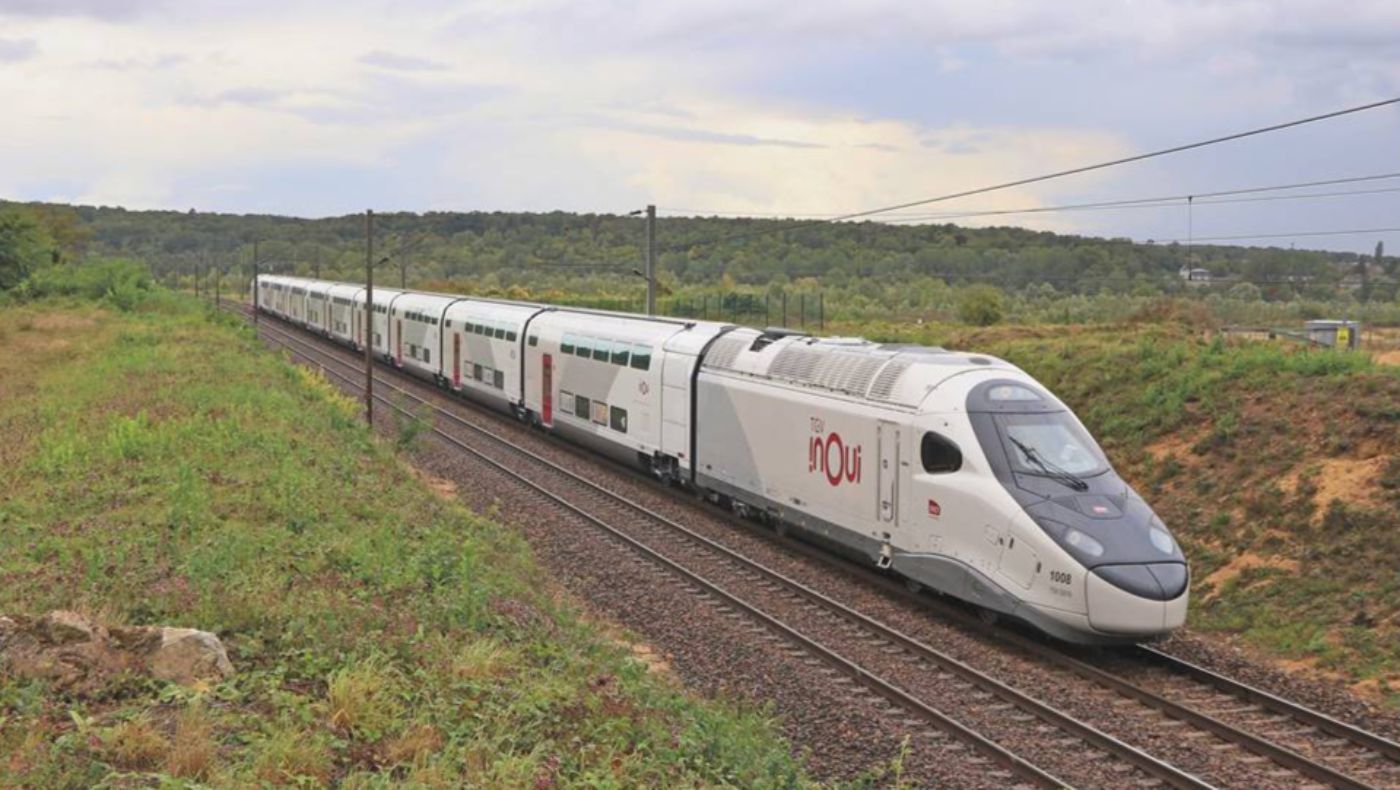
TGV Inoui production series being delivered
The first of the production series of TGV Inoui (formerly TGV M) set 1008 has been delivered to SNCF Voyageurs and is seen above on 4 September displaying the most recent livery near Changis-sur-Marne while on a test run from Villeneuve Saint-Georges to Châlons-en-Champagne. During August the million kilometres of endurance testing was completed and an application for certification to enter commercial service will now be made to l’Agence Européenne de Sécurité Ferroviaire and Etablissement Public de Sécurité Ferroviaire. The aim will then be to begin passenger service early next summer for the 2026 holiday season. Photo: Christophe Masse.
On the production series the white, cream and grey livery has been further refined: The upper part of theblack ellipse on the nose has been redesigned, the outline of the passenger access doors complies with accessibility standards, with a high contrast between the door and the bodywork to provide better visibility for the visually impaired, SNCF Voyageurs logos have been applied to the power cars with TGV Inoui branding on each carriage.
Production at the Alstom plant at La Rochelle was evident on 6 September with sets 1005, 1007 and 1009 all visible. Photo: Georges Turpin.
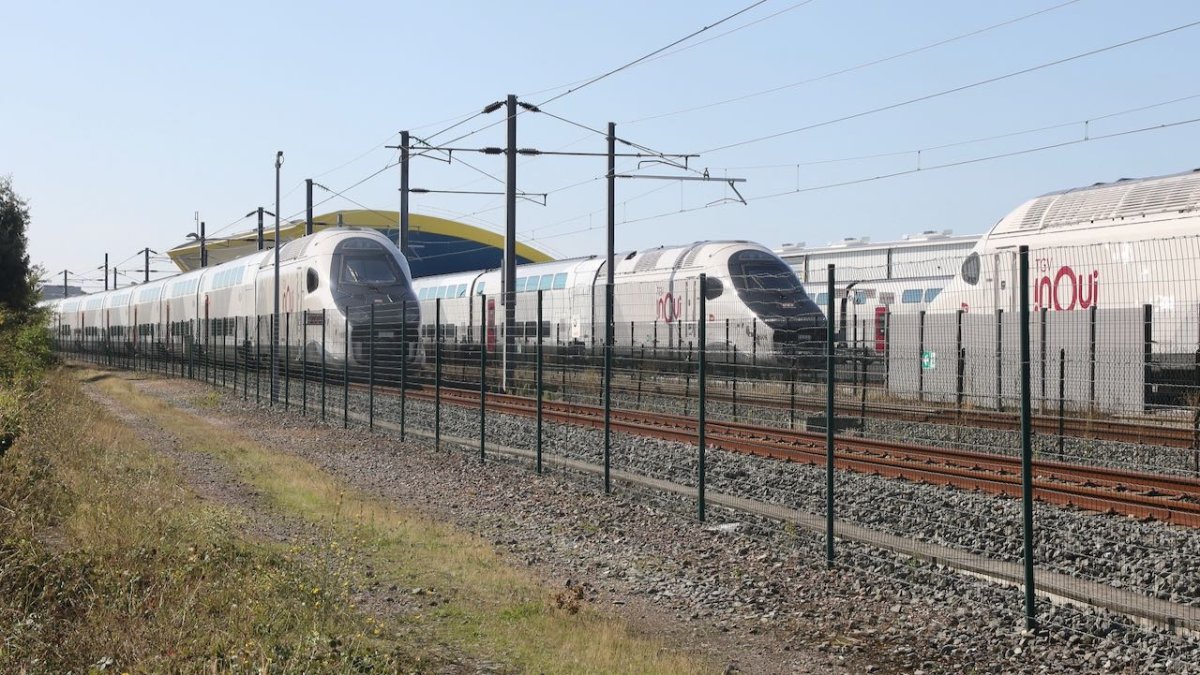
Kevin not so speedy
Kevin Speed has postponed its proposed start of operations until late 2030 having so far failed to raise the full €1.2 billion funding required. One of the several challengers to SNCF’s TGV services, Kevin Speed had hoped to launch commercial operations under the Illisto brand at the end of 2028 with hourly trains throughout the day from Paris to Lille, Strasbourg and Lyon at fares starting from €3 per 100km. Its commitment to order 20 Avelia Stream 300 trains from Alstom remains frozen until finance is in place, “by the end of the year” according to chief financial officer Guy Saidenberg.
Nevertheless, the start-up is pressing ahead with development of an operating and maintenance hub at the Coriolis industrial area adjacent to Le Creusot TGV station, a site chosen for its proximity to LGV Sud-Est, to Alstom’s Le Creusot works and to the other rail industries located around nearby Montceau-les-Mines. The fleet will be based here, creating 100 jobs in maintenance and operating.
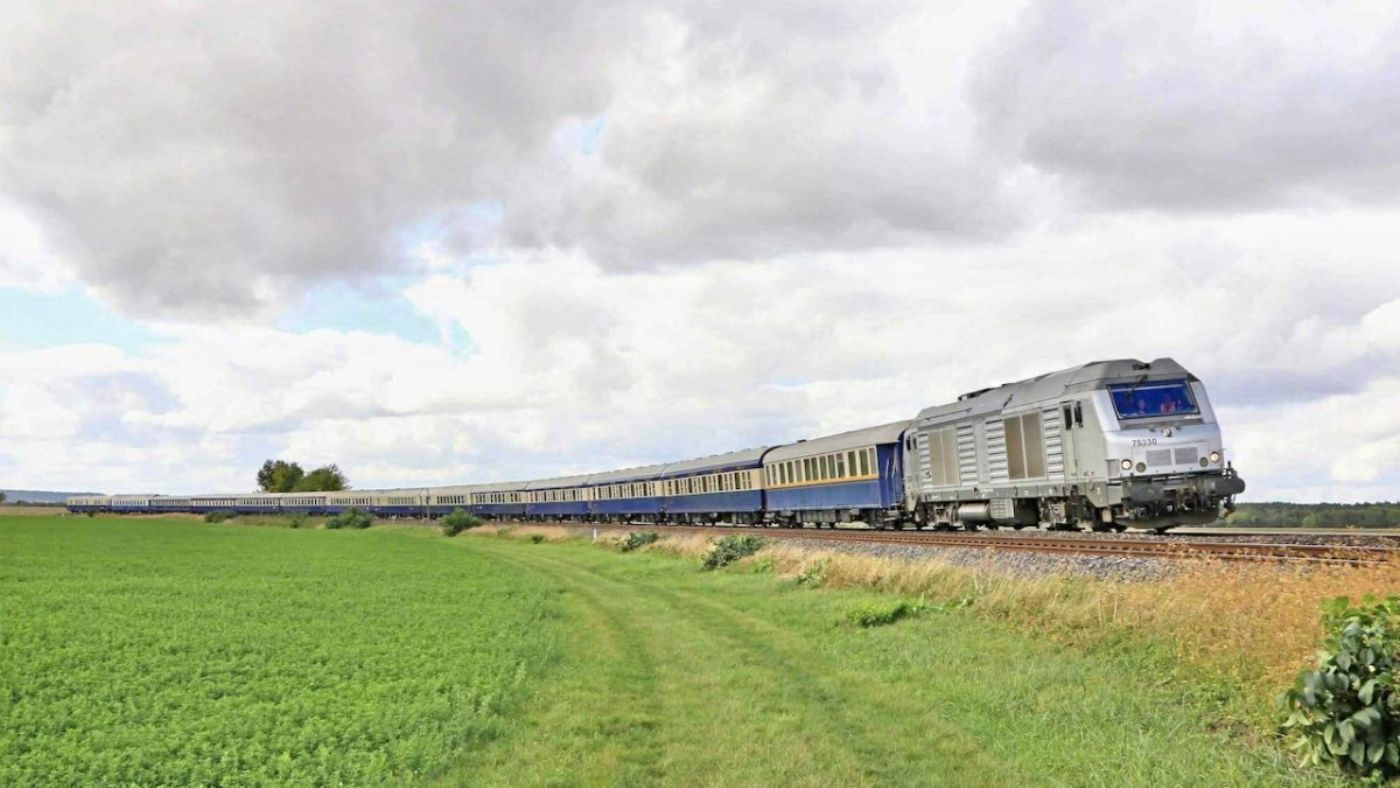
Golden Eagle Danube Express
The luxury Golden Eagle Danube Express made its second foray into France on 11 September when it arrived in Paris. The following day it departed on a seven day journey to Istanbul via Reims, Vienna (Austria), Postojna (Slovenia), Belgrade (Serbia), and Sofia (Bulgaria). The prestigious 14 coach train carries about 50 passengers with traction being provided by new rail operator Europe Express using BB 75300s leased from Akiem. Europe Express will also be providing the traction for 'Le Grand Tour' the new luxury train being operated by Puy du Fou.
The outward journey to Istanbul is seen above on 12 September on the Mourmelon curve between Reims and Châlons-en-Champagne headed by BB 75330, that worked the train to the Swiss border at St Louis. Photo: Christophe Masse.
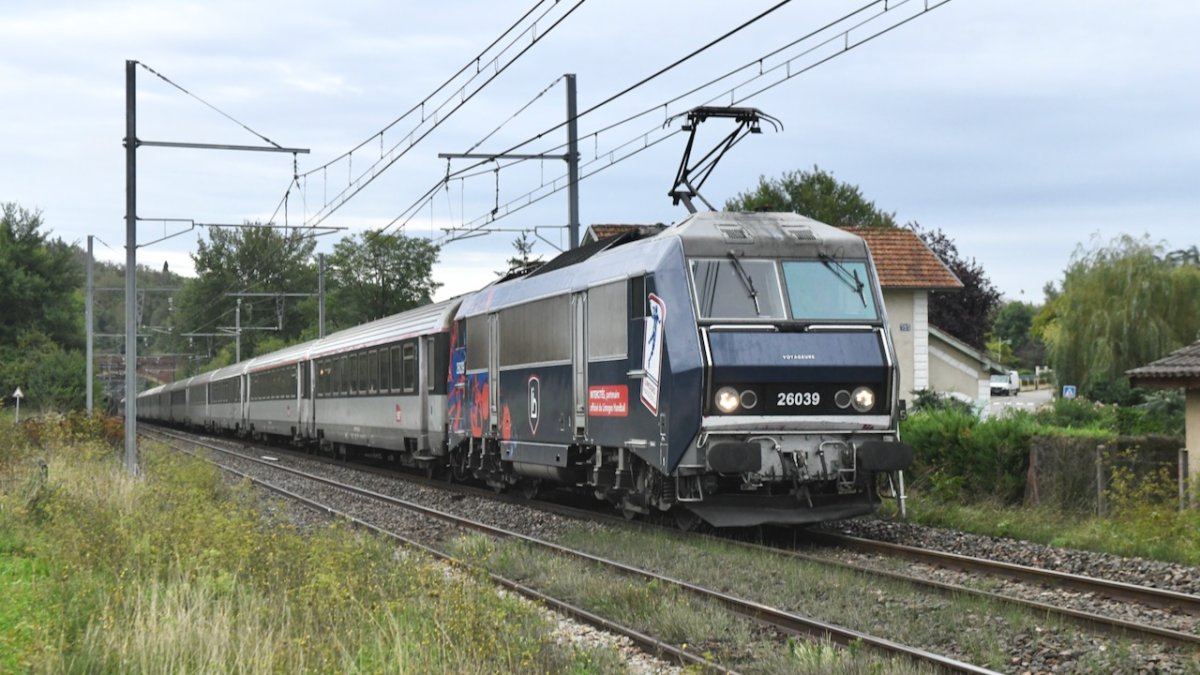
BB 26039 is the latest locomotive to receive an individual livery and has been decorated in the colours and emblems of the Limoges handball team. It is seen above on the 13 September approaching Espère with 3644 07.18 Toulouse – Paris Austerlitz.
Night train news
Bayonne/Tarbes. On the route from Paris Austerlitz to the southwest (ICN 3731/3740), trains are expected to be diverted over the Tours – Bordeaux LGV on Saturday and Sunday nights from the December timetable change. This is due to major infrastructure work on the classic line, including loading gauge enlargement for intermodal freight trains in five tunnels between Poitiers and Coutras. The cost is €15.4 million, 85% financed by the State and 15% by SNCF Réseau. SNCF Voyageurs is to receive Class BB 22200 locos Nos 22378 and 22379 on loan from SNCF Infra. These are equipped with TVM 430 cab signalling and also have bogies allowing them to operate at up to 200 km/h, although the trains will not operate at more than 160 km/h for which the Corail coaches are designed, and in order to maintain the usual journey time as far as Bordeaux. The work is expected to last at least two years.
Briançon. The trial run for Intercités Nuit took place between Briançon and Grenoble over the weekend of 6/7 September (see September News). Following arrival of ICN 5787 on Saturday morning, the empty stock departed Briançon at 14.34 as Train 791792 running via Veynes to Grenoble. The train was in trouble before it reached the Grenoble route at Aspres-sur-Buëch, losing an hour between Embrun and Chorges, and was reported 97min late at Veynes. It returned the following day as Train 701201 at 08.36 from Grenoble. Apart from the late-running, the trial was evidently successful as the train ran via Grenoble on several nights from 20 September to 2 October, retimed to take account of the longer route. From Paris, the train departed Austerlitz at 21.02 on Mondays, Tuesdays and Wednesdays, calling at Grenoble at 03.59 with Briançon arrival at 10.45. In the opposite direction, departure from Briançon was at 18.21 on Tuesdays, Wednesdays and Thursdays between 23 September and 2 October, arriving in Paris Austerlitz at 07.41. The last public stop is at Veynes, the Grenoble stop being for operating purposes only.
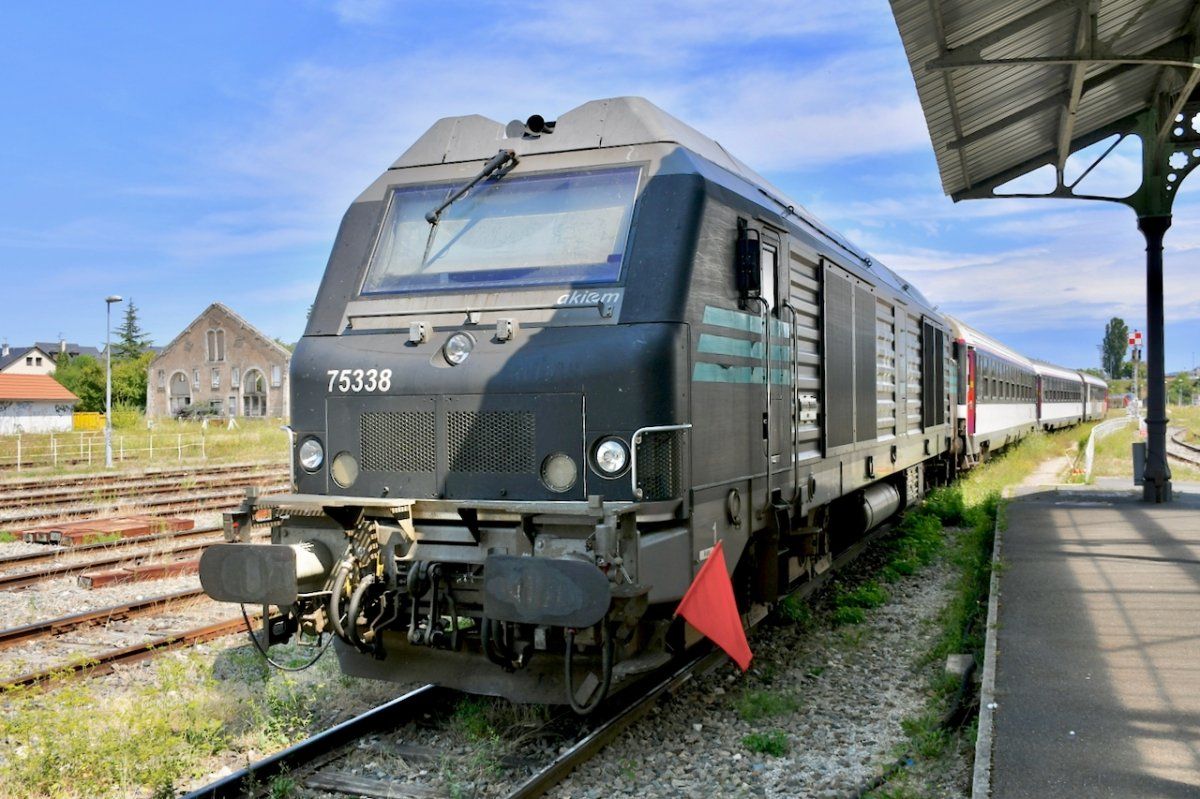
Rodez. The night train was terminated at Brive several times during August due to unspecified ‘operating difficulties’. Passengers on the 17 August departure from Paris were notified during the day by sms that they would be bussed from Brive. After the train had stood in Brive gare for a couple of hours they were woken at 02.30 and transferred to road coaches, reaching Rodez at 05.10 against the train’s 07.11 arrival time. Although the station was open, no refreshment was available until the convenience shop opened at 06.00. One passenger noted repeated public announcements as the train approached Brive and whilst the train stood in the station, ruining any chance of sleep; no apology was made for the disturbed night and no compensation offered. The train was also cancelled on the nights of 8-10 and 17-19 September.
On the afternoon of 6 August, BB 25338 waits at Rodez with the stock of that evening’s 22.16 ICN 3754 to Paris Austerlitz. The loco is one of the nine previously leased to Akiem for service with Lineas, later returned to SNCF Voyageurs for night train duty. It retains its Lineas – Your Freight Force vinyls. Photo: Jean-Pierre Fiers.
Berlin/Vienna. The thrice-weekly Paris to Berlin and Vienna night train operated by Austrian Federal Railways (ÖBB) and German Federal railways (DB), reintroduced two years ago, is to cease running from 14 December. Despite year-round occupation hitting 70%, and up to 90% in summer, France has decided to withdraw its €10 million per year share of the subsidy required, and ÖBB and DB say they are unable to bear the losses without the French contribution. Blame has been attributed to the operators’ failure to run the train every day, but SNCF said: "Even with high occupancy, breakeven is not attainable given the high operating costs”. On the evening of 25 July BB 185 557 passes Reuilly between Château-Thierry and Dormans with Train 329 Paris-Est – Kehl – Berlin/Vienna. Photo: Georges Turpin.
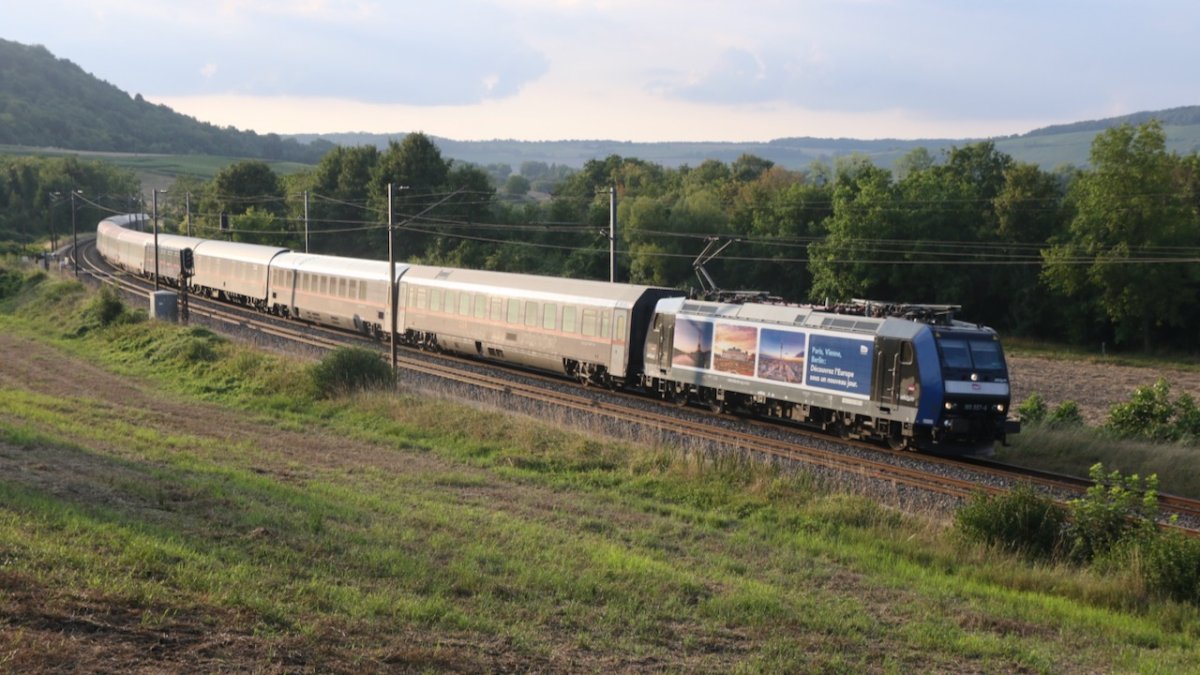
News in Brief
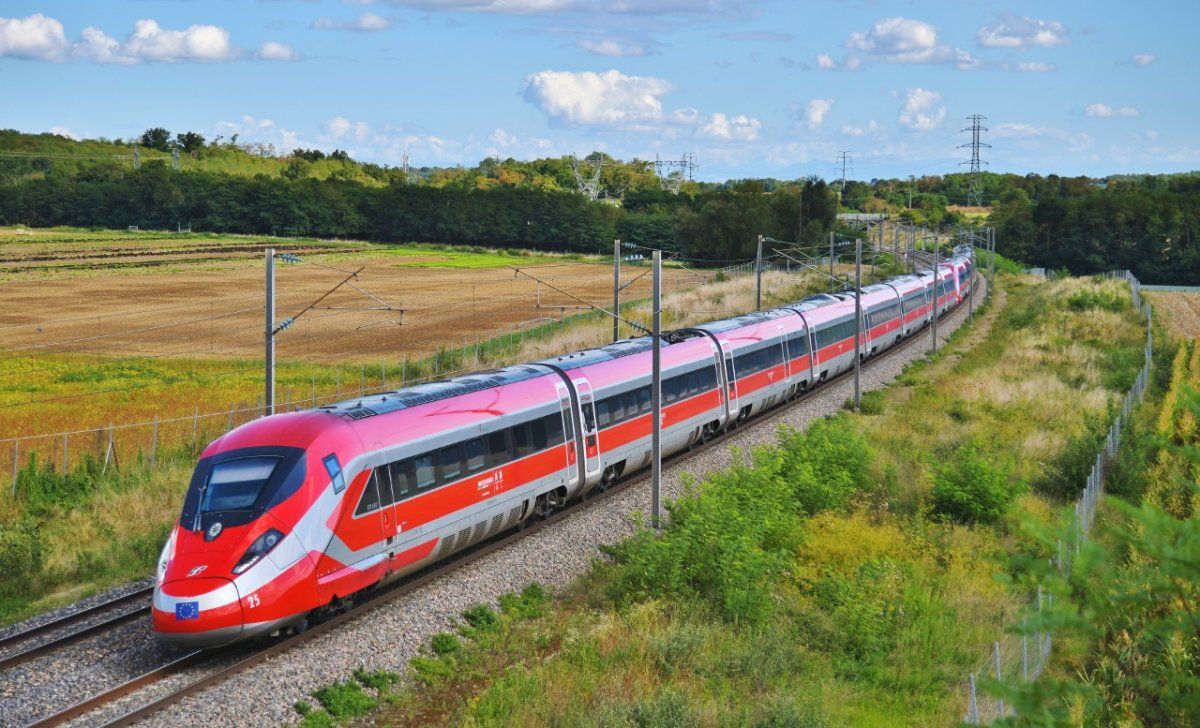
Trenitalia France. Losses increased by 36% to €68.4 million in 2024 due to closure of the Maurienne valley line which prevented operation of Paris – Milan trains. With the December timetable change, a further five Paris – Lyon A/R will be added, making 14 A/R daily; fares start at €23. Having rapidly achieved a load factor of 70%, Trenitalia France now intends to consolidate its position rather than developing new routes. It will seek to grow the business travel market in the hope of achieving profitability in 2027 or 2028. On the busy rentrée weekend of 30-31 August, double rakes of Frecciarossa were run for the first time on the Paris – Marseille route. Train 6105 from Marseille to Paris is seen at Cailloux-sur-Fontaines on the Lyon bypass on 30 August. Photo: Pierre Julien.
September unrest. The 10 September Bloquons tout protests against budget cuts saw most TGVs running normally but patchy suburban and TER service with some lines completely closed. Countrywide, at midday 19% of trains were cancelled, rising to 24% in the evening peak. Tramways were targeted, with depots and tracks blocked at Bordeaux and Nantes; protesters chained themselves across the tracks in Dijon.

TER access charges. Seven régions appealing against SNCF’s access-charge increases for 2024, 2025 and 2026 had their case rejected by the council of state on 3 September. A ruling last year found in favour of the régions though only on procedural grounds; the further attempt to seek a reduction in the charges was turned down.
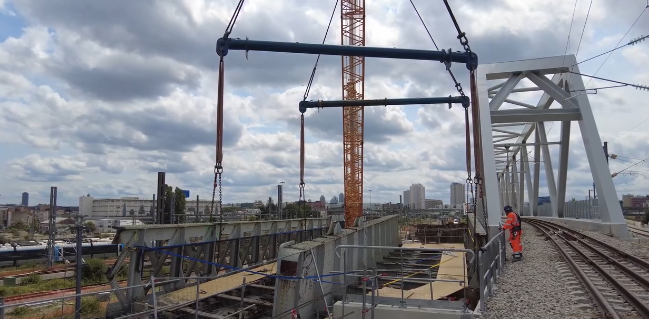
Pont des Cathédrals. The weekend of 15-18 August saw the final push for completion of Pont No 1 (Pont des Cathédrals) between Gare du Nord and Saint-Denis, with the new bridge (right) carrying trains for the first time on the 18th. Associated works to connect new track and sidings to the Saint-Denis signalling centre were also carried out. At Le Bourget, three new storage sidings were brought into use, completing work started in 2022 to allow RER Line B trains to turn back there and at La Plaine Stade-de-France in the event of disruption, financed as part of the CDG Express project.
Photo: SNCF Réseau.
Veynes. Voie C, the station’s longest platform loop, is out of use for at least six months due to the degraded state of the rails. SNCF Réseau apparently has no suitable replacement rail in stock. Meanwhile, three trains will be unable to pass in the station, delaying services and breaking connections between the four routes.
“I’m on the train!”. An unwelcome aspect of the new Transilien 2NG trains is the interruption to phone coverage caused by thermal filters in the glazing, intended to reduce heat-transfer but which also block mobile phone signals. With Line N’s trains apparently suffering worse than others, by January all 9,765 windows on the 73 sets will have been micro-engraved at Montrouge depot to allow waves to pass.
Saint-Étienne. Following weeks of local industrial action which caused disruption and cancellation of services from Saint-Étienne/Firminy to Lyon, AURA région pressed SNCF for resolution of the dispute before the rentrée on 1 September. Signallers at Saint-Étienne are complaining of staff shortages but SNCF is adamant that the correct complement is in place. The action was called off but Sud-Rail warned that SNCF’s offer was ‘only a palliative’ and did not rule out further strikes.
Getlink. Subsidiary Eurotunnel has launched its solar farm project which by 2028 is expected to produce sufficient electricity to power all trains through the Channel Tunnel. Some 80,000 panels will be deployed on brownfield sites at Coquelles, Fréthun and Peuplingues.
La Grand' Combe. The station building and its passenger and staff facilities have reopened following an incident on 30 March when shots were fired nearby and staff threatened. Trains resumed calling a few days later, but personnel had refused to work at the station until security was improved.
Pont-l’Éveque. Consultation is underway for SNCF’s bridge over the Seine-Nord Europe canal near Pont-l’Éveque between Paris and Tergnier. A 2.2km diversion will be built to access a 100m-long Warren truss carrying the railway over the canal at a height of 10m above water level.
Auch. Fears that the line from Toulouse, the only railway in Gers département, would close next year on safety grounds have been rebutted by SNCF Réseau. Renovations costed at €4 million are ‘financed and programmed’ for late-2026 it said. Occitanie région and the State will contribute.
Agde. Work has started on a three-year project to make the station fully accessible, build a multimode interchange and replan public space. The modernised station will become the link between the old town and the Mediterranée development on land to the north. Total cost is €32.8 million.
Pont-de-Dore. X 73622 on 09.02 Clermont-Ferrand – Thiers broke down ahead of the level crossing at Pont-de-Dore on 8 September. As the train had ‘struck in’, the barriers remained closed whilst staff were summoned to raise them manually. The sole passenger said he was in no hurry and declined to leave the train, which was later towed to Clermont by another railcar.
Aix-en-Provence. Renovation of the Arc de Meyran viaduct is disrupting Marseille – Aix trains until December. The 576m-long curved structure, a feature in paintings by Paul Cezanne, is being waterproofed and safety rail renewed. Work is also being carried out for the new Plan-de-Campagne halt between Septèmes and Simiane, where a multimodal interchange is being built. Buses replace trains on weekdays between 09.30 and 15.30.
Poitiers – Limoges. Reopened throughout on 20 September on completion of rehabilitation. Poitiers – Le Dorat has been closed since January for infrastructure and drainage improvements, relaying of 50km of track and modernisation of signalling. Service improvements come with the December timetable.
Léman Express. On 10 September, the canton of Geneva agreed a contribution of €135,000 towards the €540,000 studies being carried out by AURA région into adapting the network to accommodate the proposed new fleet of double-deck EMUs.
Draisy. At a meeting on 3 October, Occitanie région was expected approve spending of €129,000 on studies and work to equip the Carcassonne – Limoux line for trial operation next year of the Draisy lightweight railcar.
Seat numbering. From mid-September, SNCF is changing seat numbers of TGV Inoui sets. Following the system already in operation on Ouigo trains, seats will have three-digit numbers, the first of which will be the coach number.
MI20 trains. Following the estimate by an independent arbiter that the first MI20 trains might not be available until September 2029, nearly four years late, Alstom’s PDG committed on 22 September to have the first in service by late-2028. An Alstom/CAF consortium is building 146 double-deck trainsets for RER Line B. The delivery schedule has slipped substantially and ÎdeF Mobilités pressed the manufacturers to recover lost time.
Several main line stations were blockaded; Gare du Nord in Paris was besieged by around 1,000 protesters and had to be evacuated.
There were many attacks on rail infrastructure, including cables cut, arson, and trees placed across the tracks. Despite the disruption, the following morning’s peak-hour saw just 4% of trains cancelled. Incidents of vandalism, cable-theft and arson plagued the network over the following days. A week later, the 18th was an official strike day for rail unions with fewer trains running; SNCF said that 90% of TGVs had operated normally. At midday, 34% of all trains were cancelled, and 40% at 17.00. Photo: Ouest-France.
Short freights. A 2.6km section of the branch serving the Weylchem chemical plant east of Compiègne was renewed over the summer holidays, reopening on 25 August. The 12km to Lamotte-Breuil is a remnant of the former line to Soissons, closed to passengers in 1938; it is served by Lineas France from Tergnier.
At Rouxmesnil outside Dieppe the 4km line to Arques-la-Bataille reopened on 11 September with two trains a week serving the Eurovia civil engineering depot at Saint-Aubin-le-Cauf.
SNCF Réseau is upgrading the 4km freight line from Lannemezan to Labarthe-Avezac, part of the former route to Arreau (closed 1969), which serves the industrial zone at Avezac-Prat-Lahitte.
Beware imposters. The latest fraud visited upon SNCF passengers is fake train staff who try to charge on-the-spot fines or extract personal information. SNCF has intensified efforts to combat this type of fraud and bolster public confidence in its staff. Legitimate ticket inspectors have uniforms with clearly visible insignia, an identity card with photo and hologram, and a unique ticket scanning device. SNCF said passengers should not be afraid of demanding staff ID if they have any doubt. Unfortunately, confidence has been eroded by widespread reports of staff fining passengers for minor infractions of the regulations (eg a cat in a basket deemed to be miaowing too loudly!).
Bordeaux. Talence-Médoquine station opened on 21 September served by TER Line 41 Arcachon – Bordeaux – Libourne (half-hourly at peak times) and Line 42 Le Verdon – Bordeaux (every two hours). The original station at the junction between the Midi main line and the Médoc branch was closed in 1949. Buses run every 5min to the university and the Pellegrin regional hospital. The first train to call, at 08.07, was TER 866309 08.03 Bordeaux to Arcachon.
Epône-Mézières. The rebuilt station here was officially opened on 16 September following four years’ work to accommodate RER Line E trains from 2027
RER Line A. Since 1 September has double-length trains in the evening every weekday instead of just Fridays and Saturdays. Monday to Wednesday Trains Longs (two five-car sets) run until 23.00, and on Thursdays until the end of service. Neuilly-Plaisance station on the Marne-La-Vallée branch, where a four-year upgrade of facilities starts this month, is now served by all trains, an additional 38 daily.
Vittel. Public consultations began on 15 September into rehabilitation of the Nancy – Contrexéville line. Discussion centres on Nova 14’s request for derogation from the requirement to protect certain species during reconstruction, and approval to abolish 21 level crossings. Work is expected to start at the end of November, with reopening scheduled for 12 December 2027. Recruitment of construction personnel is underway, and 65 operations staff are to be taken on over the next two years. Transfer terms will be offered to SNCF employees.
Grand Est. Introduction of extra capacity for Metz – Luxembourg services started on 15 September when nine-car 2N double-deck trains (three x three-car)) ran for the first time on the overcrowded TER 88753 17.16 from Luxembourg, providing an additional 340 seats. This follows delivery of Class 2400/2450 sets to Luxembourg Railways which has freed-up more Class 2200 sets for cross-border services. From early next year, Grand Est will have available the first Z 24500 sets bought from Normandie région which are currently undergoing homologation for operation into Luxembourg.
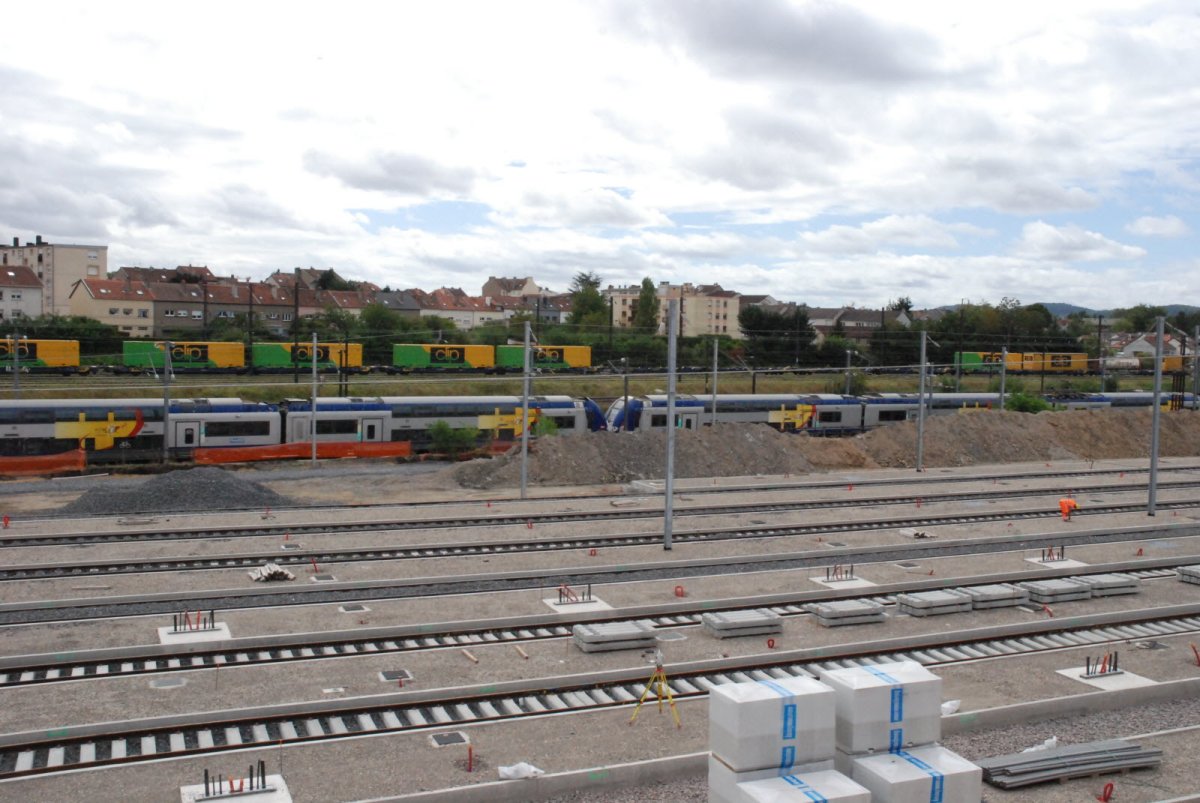
The TER Technicentre being built at Montigny-lès-Metz is taking shape, with tracks laid and some equipment installed at the 12Ha site which will be the région’s largest, with capacity for 41 2N trainsets. The €105 million cost is shared between GE and Luxembourg. Photo: Le Républicain Lorrain.
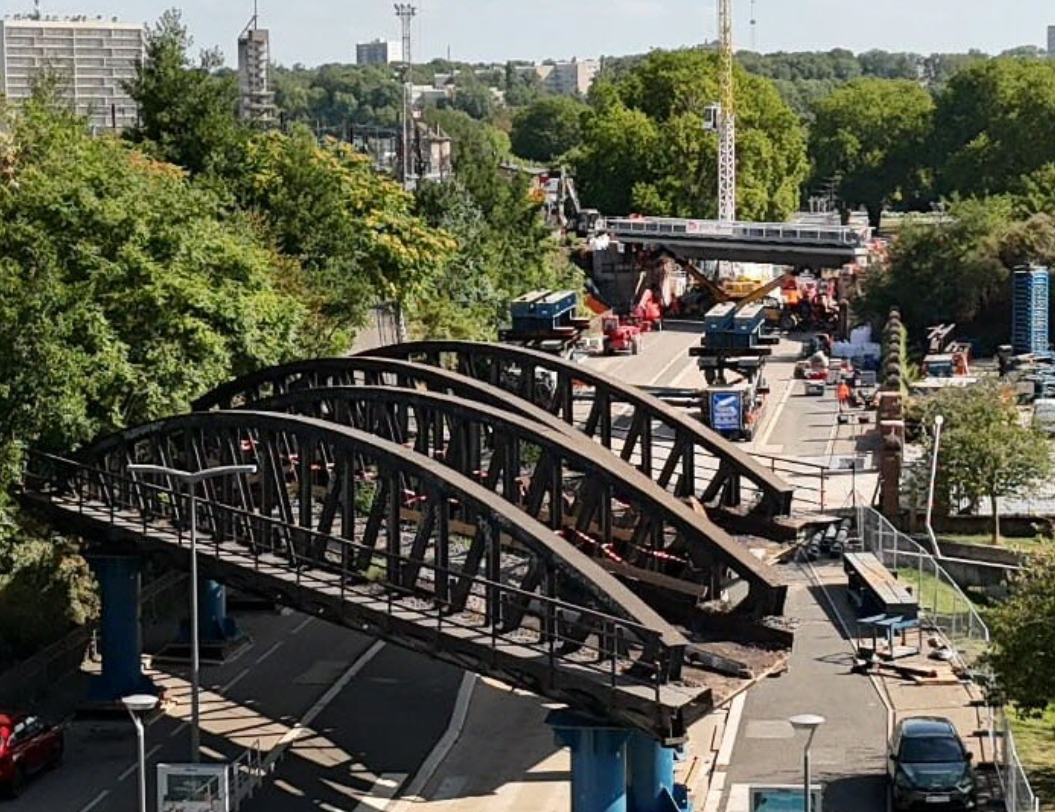
Metz. The 1904 bridge over avenue de l’Amphithéâtre, which carries the Metz-Ville to Metz-Marchandises freight avoiding line, is being replaced at a cost of €6.5 million. The new structure was slid into place during a 98h blockade over the 15 August weekend, during which freight trains ran via Metz-Ville station.
Photo: Le Républicain Lorrain/GW.
EuroAéroport. The transport ministry has withdrawn support for the project to build a rail link serving Bâle-Mulhouse EuroAéroport, pending an application for EU funding. The 6km loop and airport station is costed at €436 million, part of which would be contributed by Switzerland and Germany.
Alpine Rail Highway. The Autostrada Ferroviaria Alpina intermodal service operated by SNCF and Trenitalia between Aiton in the Maurienne valley and Orbasso (Turin) looks to be at an end; 18 of the 20 employees were made redundant at the end of September. Plagued by operating problems since start-up in 2003, the service did not resume when the Maurienne route reopened in April after 18 months’ closure.
Bordeaux – Marseille. A cable fire at Villenave-d'Ornon on 14 September led to suspension of train services between Bordeaux and Langon. This caused diversion of some Bordeaux – Marseille Intercités services to reach Toulouse via Dax and Tarbes, adding about three hours to the journey. Trains had to be exclusively BB 7200 hauled as BB 26000s are not passed for this route. Four days later on 18 September, following an accident at a level crossing in Cadaujac, also between Bordeaux and Langon, TGV 8501 Paris Montparnasse – Toulouse was also diverted via Dax and Tarbes with a three-hour delay.
Région Sud, Transdev and passengers’ association Fnaut complained of ‘serious defamations’ circulating on social media, including exaggerated claims such as ‘trains not cleaned for months’ when most of the rolling stock is brand new, and that a train had been immobilised for 14 hours which failed to mention that its passengers were speedily evacuated and service was maintained by two-way running on the adjacent line. Région Sud’s transport vice-present Jean-Pierre Serrus said “nothing suggests the service has declined since Transdev’s takeover”. The number of passengers carried was up 15% on the same period last year and punctuality in the first weeks of operation was 95.3% against the planned 97.5%, with only four significant incidents occurring in 1,700 services.
As to fares, these are set by the région not the operator, so the discrepancies complained of must have existed before Transdev took over. Dynamic pricing means that TGV Inoui between Marseille and Nice can be cheaper than the TER fixed fare of €40.80, with some TGVs offering a first-class seat for €35.
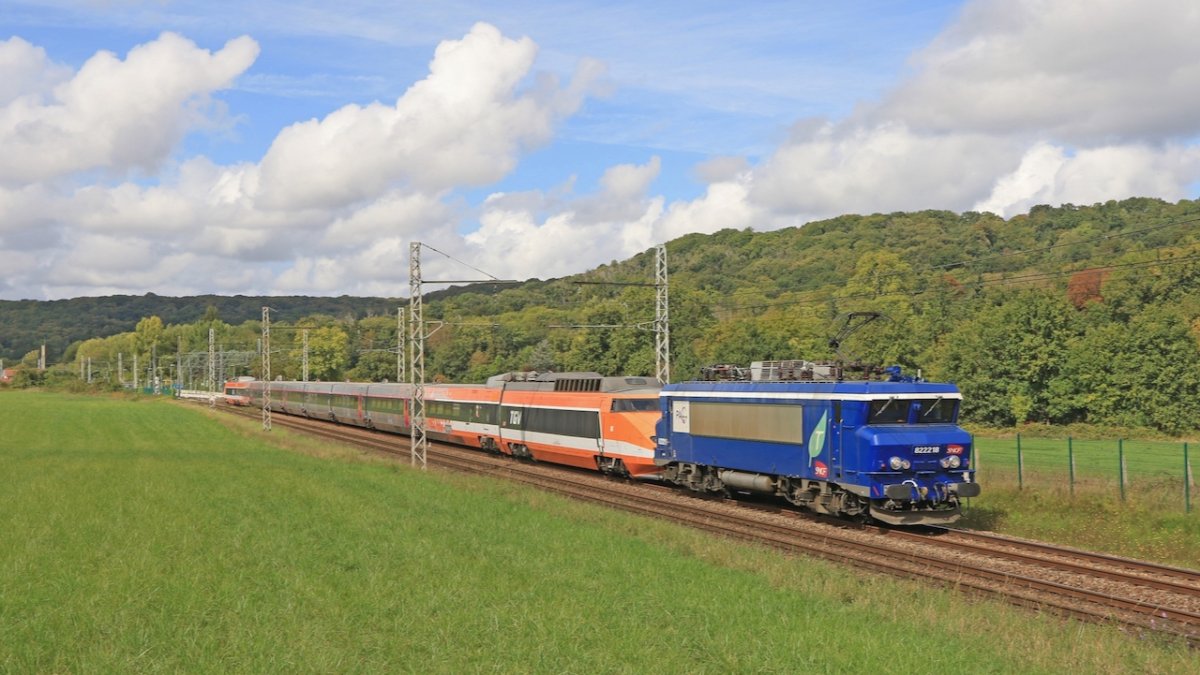
Journées européennes du patrimoine
The annual Journées européennes du patrimoine took place over the weekend of 20/21 September with numerous SNCF locations open to the public, whilst most preservation organisations held events. TGV 16 was on display at Technicentre Atlantique and is seen above returning to Villeneuve behind BB 22218. Photo: Christophe Masse.
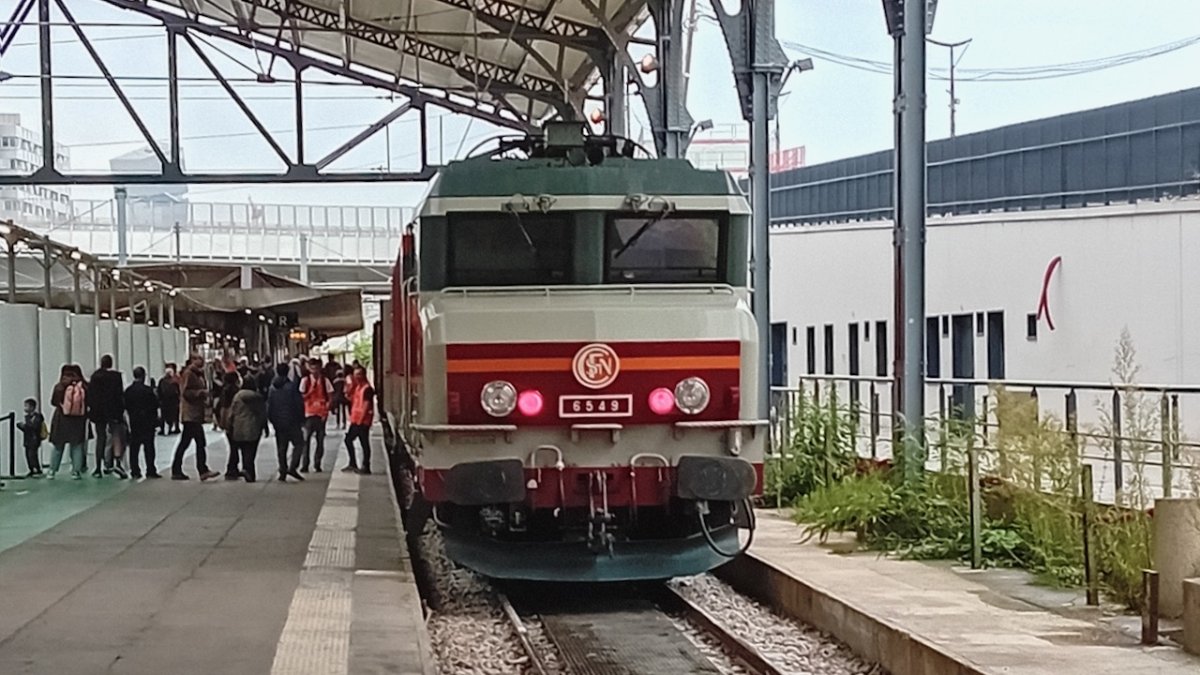
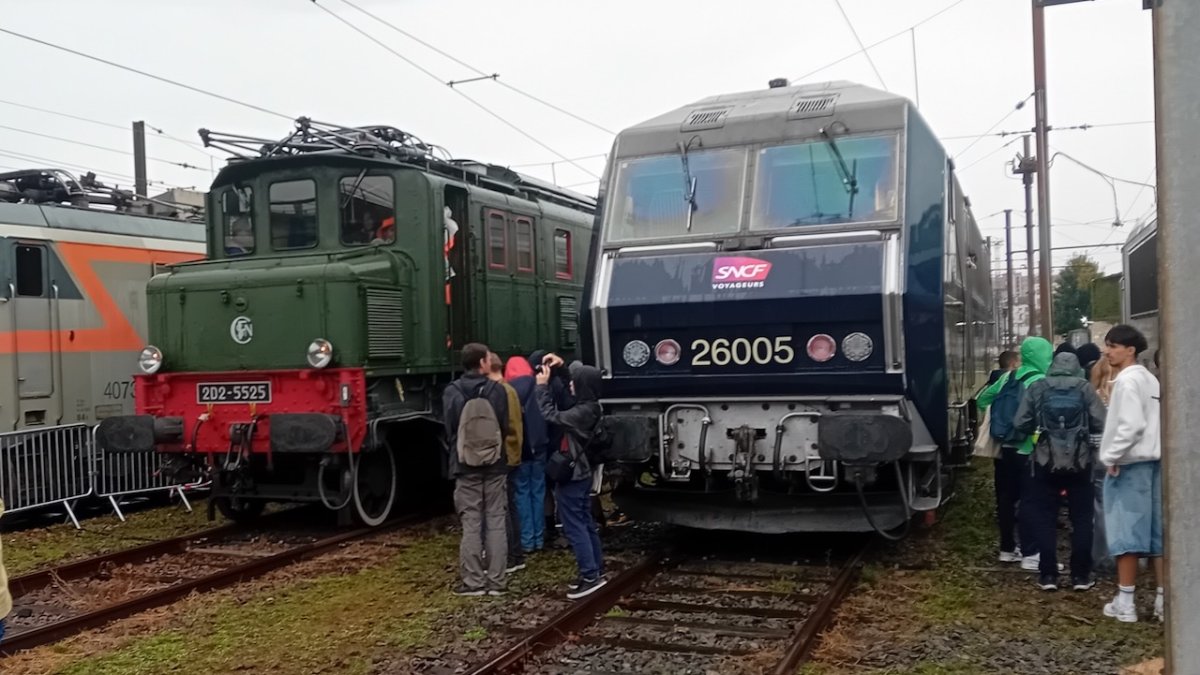
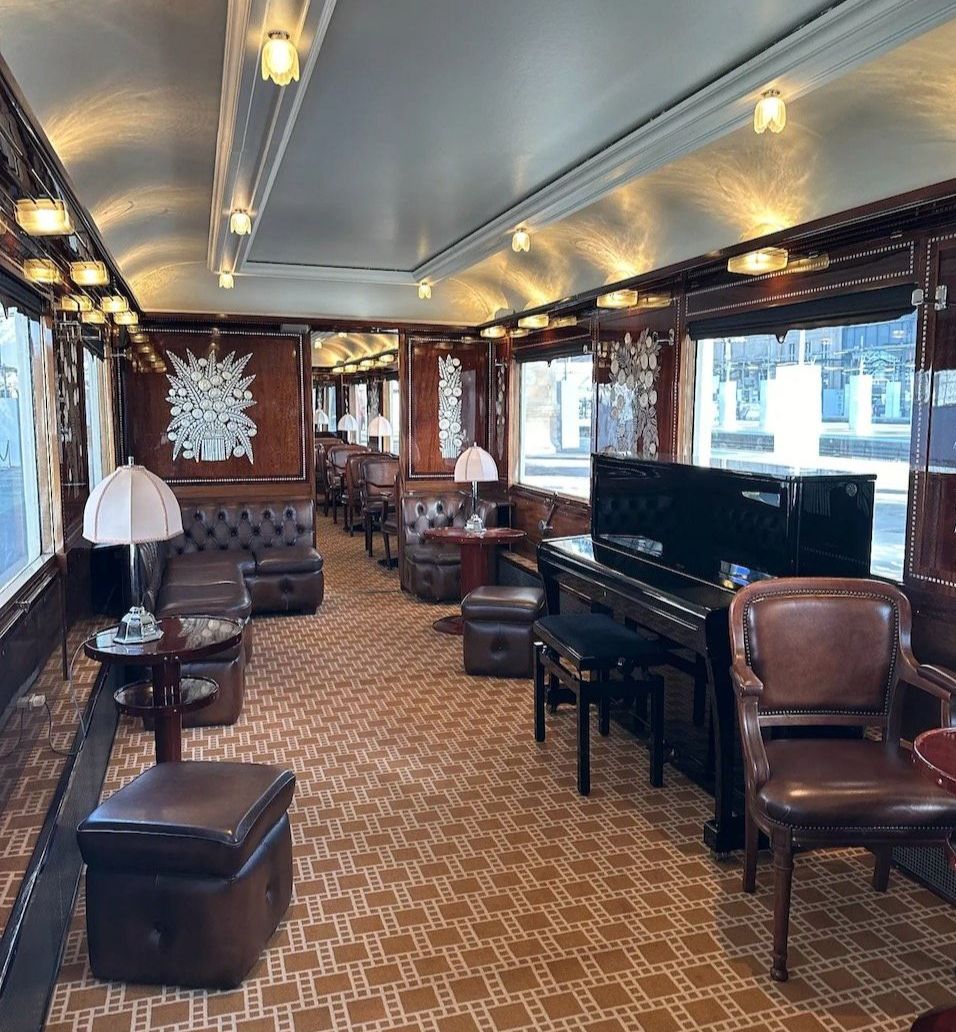
At Paris Austerlitz on Saturday 20th, APMFS provided navettes to Masséna Carriage Depot topped and tailed by CC 6549 and CC 6558. The following day they operated between Vierzon and Bourges.At Masséna Y5111, Y5208, Y8427 and BB 7308 were giving cab rides while BB 7205, A1A 68540, BB 26005, 2D2 5525, CC 6530, 141R 840, and Oxygéne set 003 were on static display. Photos: Martin Barnsdall.
Back at Austerlitz, seven restored CIWL coaches from the Accor Orient Express were open to the public. Built between 1925 and 1929, they were discovered stored on the Belarus/Ukraine border in 2015. Photo opposite: BFMTV.
Elsewhere, the main SNCF Technicentre at Saint-Pierre-des-Corps was open for the first time since the 2012 Journées du patrimoine, with 4,500 visitors on the Saturday. Photo: La Nouvelle République.
Lyon Poste 1 at Perrache station was open to the public. Built in 1933, this is the last of 26 similar boxes and was taken out of service in 2016 when its functions were transferred to the central control room at Jean-Macé station in the 7th arrondissement. It is now preserved as a monument historique. All of the electrical equipment is still in place. Below right the main console and optical control panel. Photo: France3.
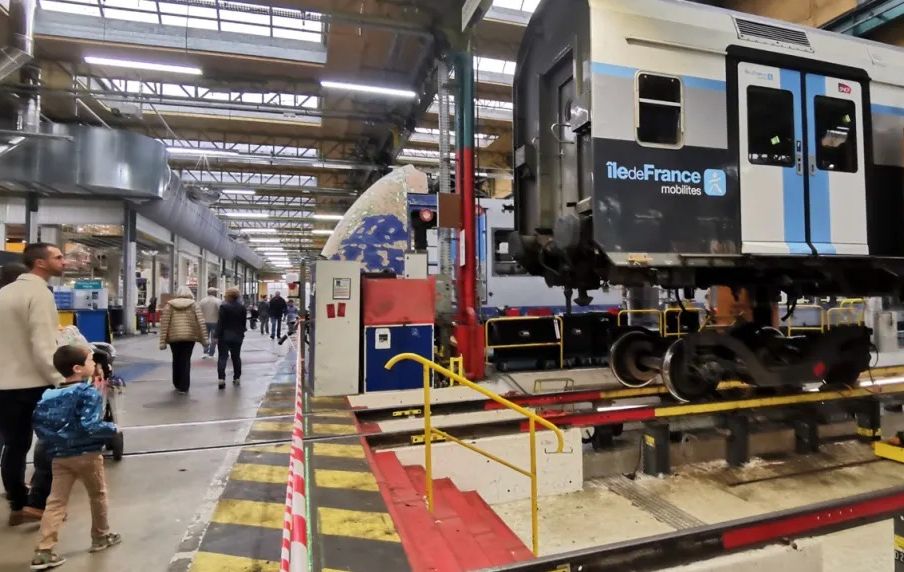
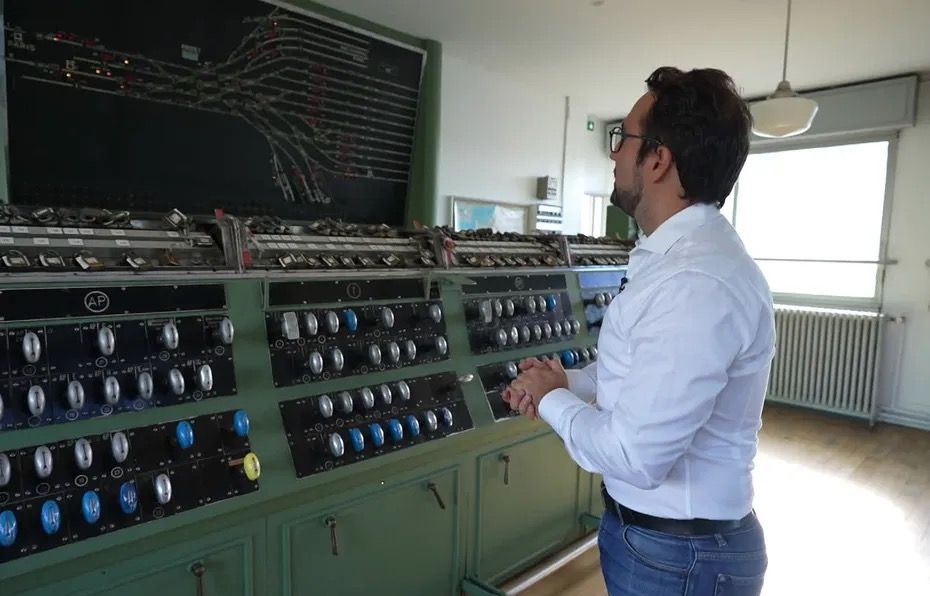
Rural Rail
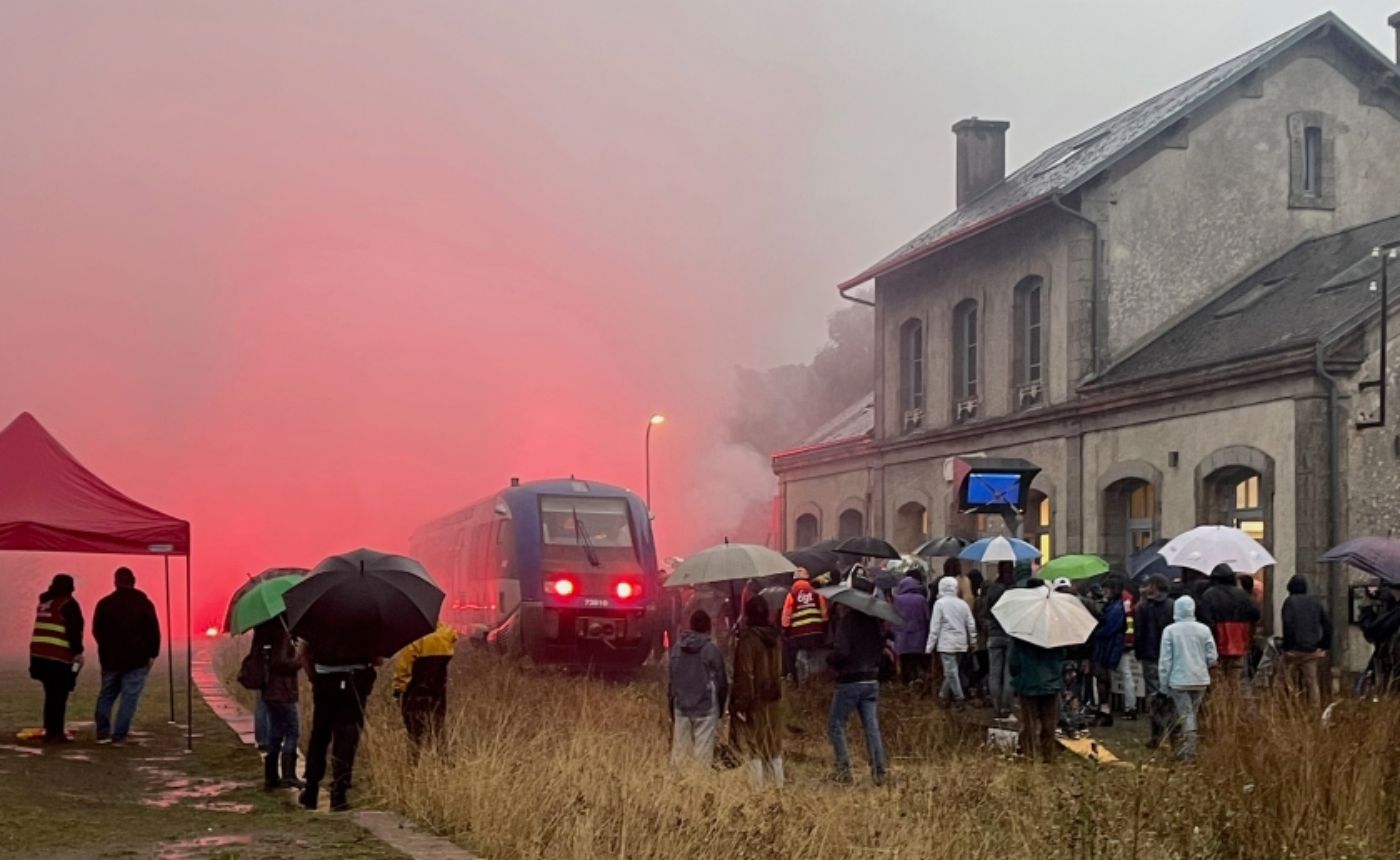
Felletin goes out with a bang
Felletin’s last train arrived in torrential rain at 19.10 on 31 August, greeted by a hail of detonators and around 150 protesters. Shortage of signalling staff had caused cancellation of several trains in the week before closure as the signalboxes at Guéret and Busseau-sur-Creuse were only open for the afternoon shift. No trains ran to or from Felletin on Saturday 30 August and the morning departure from Limoges (TER 868724 at 09.15) on Sunday was also cancelled, disappointing those who braved the poor weather to make a last trip or take photographs.
Thus the train which had arrived in Felletin at 19.10 on Friday the 28th (X 73568) remained there all weekend (with crew taxied to and from Limoges) and formed the final departure at 17.28 on Sunday (TER 868726). Amongst the passengers was journalist Gareth David who had spent several days at Felletin recording events for his blog www.railwayworld.net, where a fuller report appears. He travelled to the junction at Busseau and then rode back to Felletin on the very last public train, TER 868716 17.10 from Limoges formed of X 73810. Once the 36 passengers had alighted and a traditional ‘last day’ coffin unloaded, the railcar departed ECS to Guéret, bringing down the curtain on 143 years of railway service at Felletin.
In the timetable from 1 September, the two former Felletin trains from Limoges terminate at Guéret, laying over there before taking up their previous departure times. Otherwise, the service is unchanged with just the two daily Limoges – Montluçon trains running east of Guéret. Busseau-sur-Creuse sees its service cut from four to two A/R (one at weekends). No longer a junction, Busseau has also lost its passing loop and signalbox, leaving a 49km section between Guéret and Lavaurfranche.
Responding to criticism that the closure leaves large areas of Creuse département isolated from the rail network, Nouvelle-Aquitaine région has replanned and augmented the local bus offer at an additional annual cost of €668,000. Routes 210 Felletin – La Souterraine and 204 Felletin – Limoges are now high-quality express services operated by vehicles with cycle racks, USB ports and wifi. Felletin – La Souterraine has doubled to 10 A/R daily, six of which connect with POLT trains to and from Paris, while Felletin – Limoges increases to eight A/R. The flat fare of €2.50 is less than one-tenth of the train fare for longer journeys. Photo: Gareth David/RailwayWorld.net.
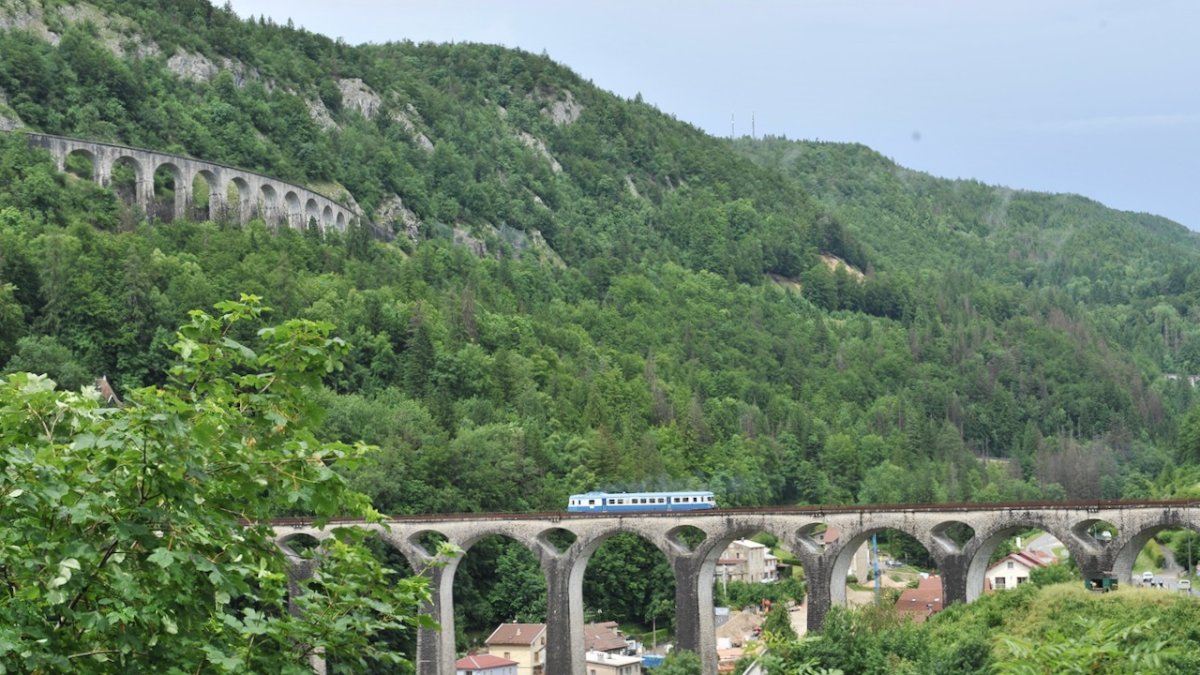
Three months to save the Ligne des Hirondelles
Earlier, Fnaut had publicised service cuts by BFC due to take place from 1 October. The Mondays-only 04.43 from Saint-Claude to Mouchard is replaced by a bus, as is Saturday morning’s 07.09 Mouchard – Saint-Claude. On Wednesdays and Fridays, the 17.12 Saint-Claude to Andelot no longer runs, an inexplicable cut as the Friday train is used by large numbers of students returning home for the weekend. Some connecting trains at Andelot and/or Mouchard have been withdrawn as a consequence, so passengers on replacement buses face even longer journeys. Fnaut also drew attention to extended journey times of between 6 and 9min for the remaining trains due to new speed restrictions.
The closure threat is a blow to local officials who have been campaigning for service improvements to help alleviate the effects of rural decline and isolation in the Jura. Saint-Claude, which has lost one-third of its population in 15 years, has just one train (at 09.53) which runs every day throughout the year. The rest of the service is geared to seasonal travel, college terms and weekending. Nevertheless, Saint-Claude saw 55% more passengers in 2024 than 2019, and the well-publicised 10.14 from Dole with its Paris TGV connection regularly attracts up to 100 participants for the various activities run by tourist offices of towns along the route.
BFC is now rallying round to see what finance can be drummed up to pay for the short-term track works, but the complete renovation project is beyond its resources. “The région can no longer [find such] funding and therefore it is necessary for the State, as owner of the line, to tell us what it wants to do with it,” said Michel Neugnot, BFC vice-president for mobility.
Above. On Sunday 15 June, X 2816 departs Morez with a Train de la fête des Pères special from L'Hôpital du Grosbois and Besançon-Viotte to Saint-Claude. Photo: Jean-Louis Poggi.
Rural railways finance. A working group has been formed by the transport ministry to revise the much-criticised financing model fordessertes fines, charged with developing ‘an up-to-date vision of the shared responsibilities for upkeep and management of rural lines’ in the current poor economic climate. Building on the work of this summer’s Ambition France Transports commission, it will report by the end of the year.
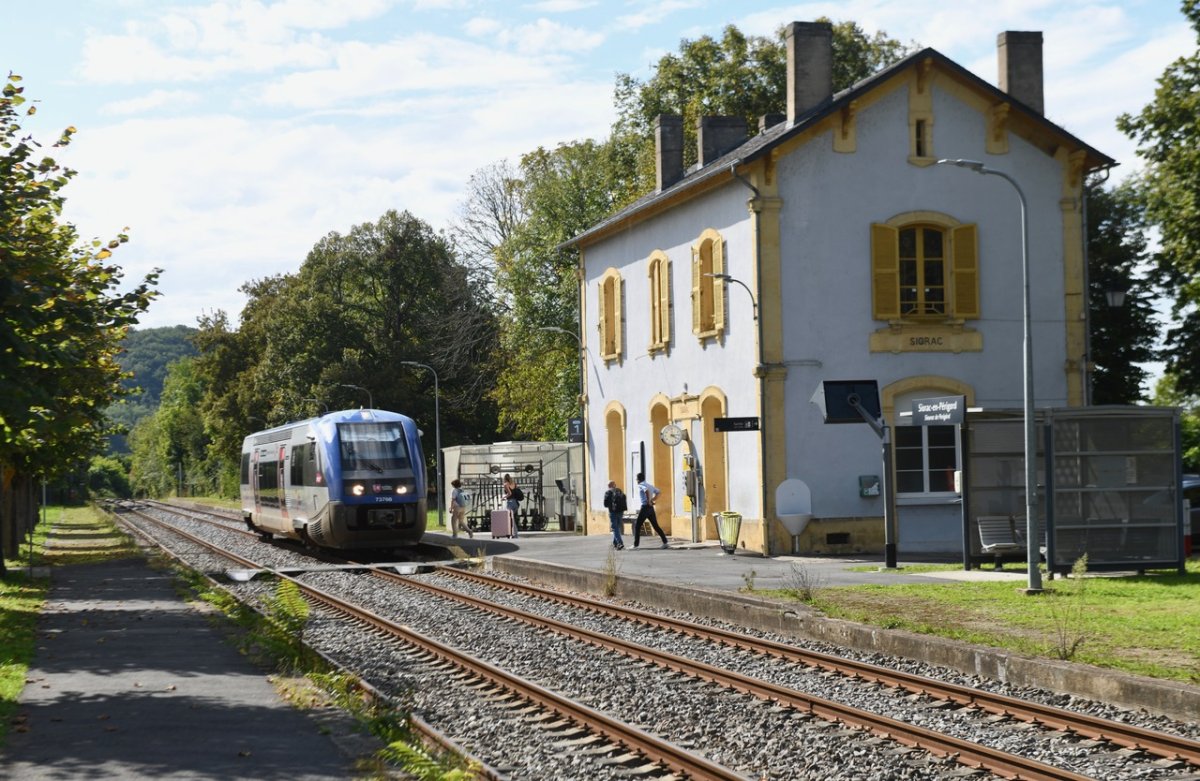
Another rural line that seems to hang on by a thread is from Périgueux to Agen. Until 20 years ago it enjoyed daily through coaches from Agen to Paris, with four coach portions detached/attached from Paris – Toulouse services at Limoges, as well as a night train. Today the line sees just two services each way (three on Fridays), with additional short workings between Monsempron-Libos and Agen. This year the service has already been suspended for two periods of engineering work (10 March – 25 April and 23 June – 31 August), and was closed again between Monsempron-Libos and Le Buisson on 15 September until 24 October except for a Fridays-only evening train each way. Between Siorac-en-Périgord and Le Buisson the line is double track and shared with Bordeaux – Sarlat services. This section is still mechanically-signalled with one of the last two mechanically-controlled level crossings in France at Le Buisson; no lights or bells, just a barrier that slowly descends.
Above. On 9 September X 73768 has arrived at Siorac-en-Périgord with the 15.16 Périgueux – Agen; three passengers are waiting. Signals and points are controlled from the lever frame beside the station building. Once the train has taken the Agen line at the junction (the RH track in the photo below left) just east of the station, the point levers are locked for the night as the remaining services are all between Bordeaux and Sarlat. Below. Facing (left) and trailing (right) crossovers at the junction of the Sarlat and Agen lines are controlled by wires, now very rare in France. Further details on the operation of this system can be found at the end of this website:
https://atelier-bruno-moret.blog4ever.com/leviers-d-aiguille-et-transmissions-rigides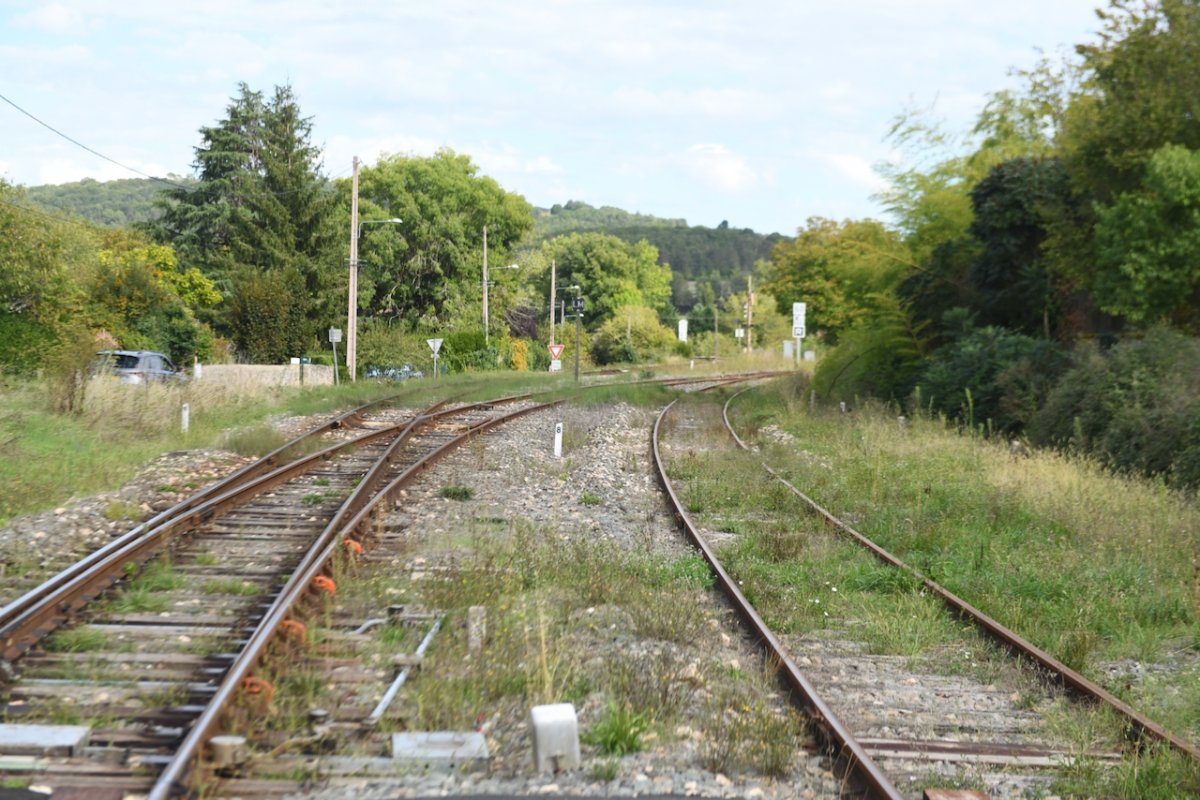
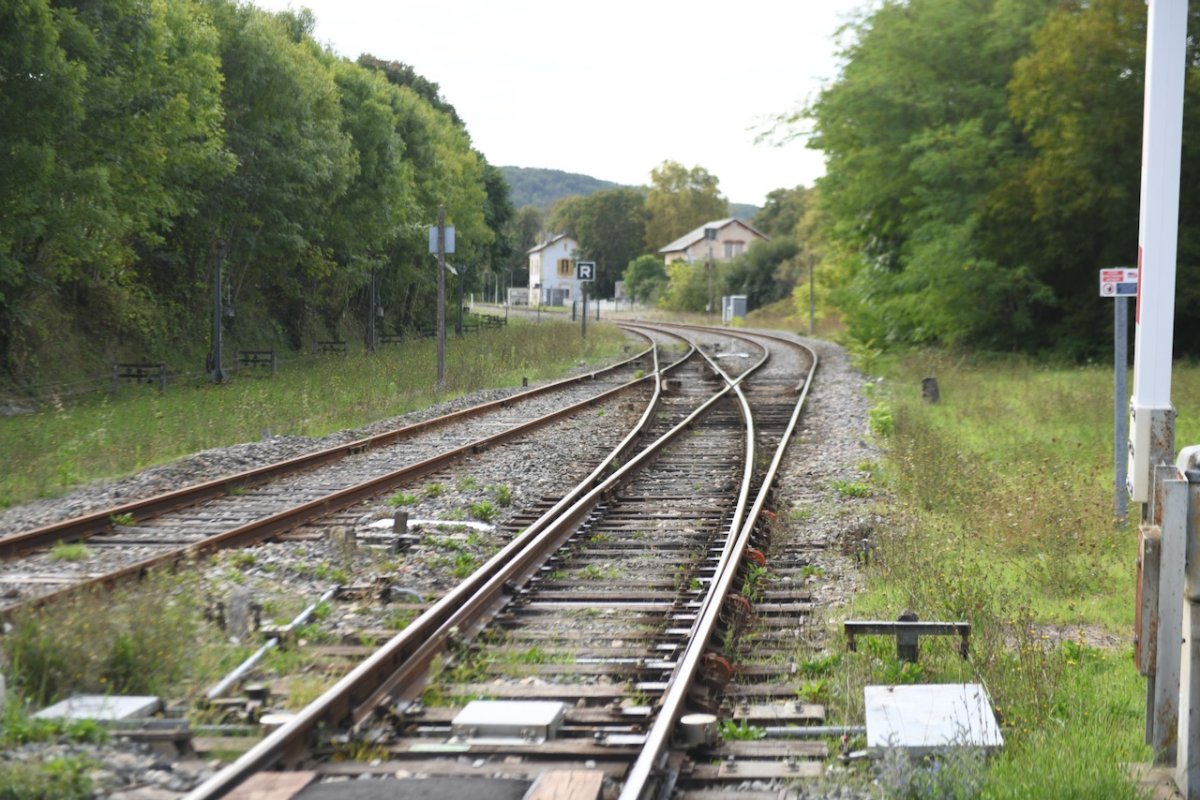
Grand Est. Has approved expenditure of €38.3 million for renovation of the lines from Saint-Dié-des-Vosges to Molsheim and Arches (Épinal). The 49km to Arches is in a very rundown state and work is currently underway to replace 3km of track at Biffontaine and renew five level crossings. €3.1 million of the new money will cover unfunded work found to be necessary in this stage of the line’s upgrade. Further work next year will cost €25.5 million; 17km of track will be renewed and 20 level crossings upgraded to current safety standards.
On the line to Molsheim, €9.7 million is to be spent in 2026-27 on track upgrading to raise running speed and preparatory work at Schirmeck-La Broque where a maintenance depot is to be built.
At its meeting on 19 September, the région’s transport committee heard that the funding was urgently needed to reverse ‘decades of underinvestment that has weakened [the ability] to assure everyday service’. The work would eliminate the risk of closure and prepare the two routes for opening of the rail market to competition.
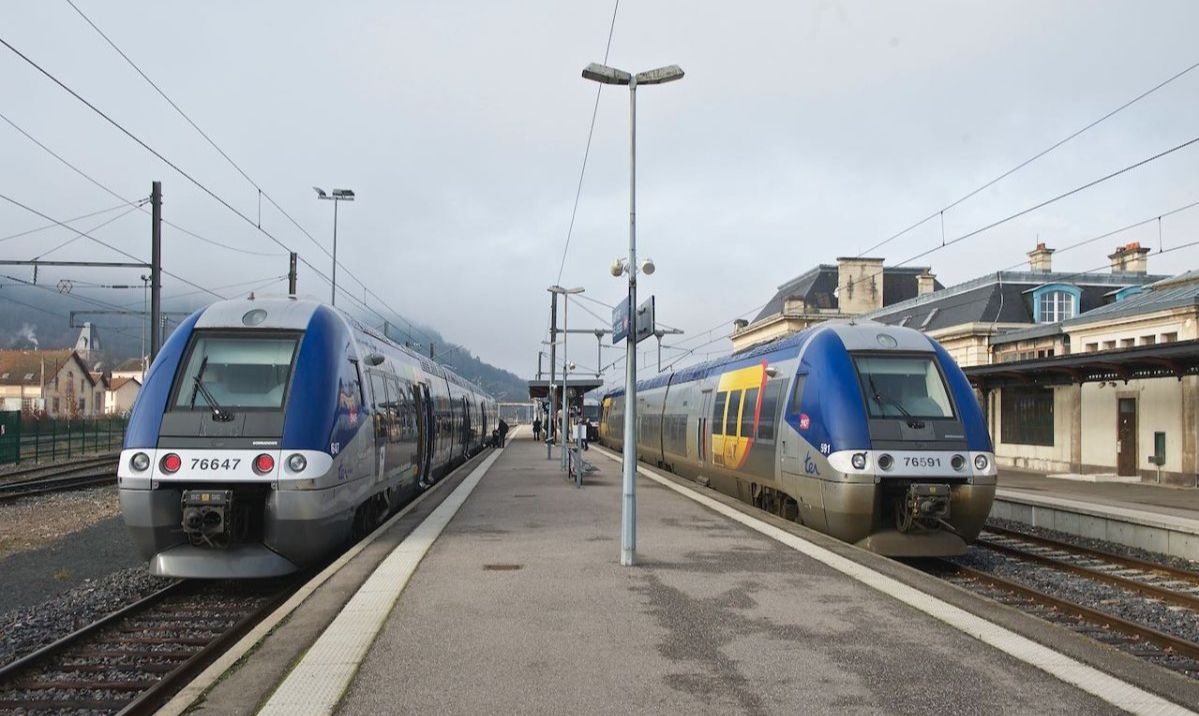
Aubrac ambition. Local officials and supporters of the Béziers – Neussargues – Clermont-Ferrand line commemorated the 30th anniversary of the Parc des Grands Causses on 14 September with an open letter to government setting out their demands for improvements. Straddling two régions (Occitanie and AURA), serving six départements and four national parks, the Aubrac is described as France’s ‘most neglected Intercités route’, with its single daily TET train failing to cater for the needs of a rural population of 2.6 million. The letter calls for:
● Complete modernisation of the infrastructure to future-proof the line, including replacement of the remaining 50km of life-expired rail.
● Use of bimode MUs to avoid change-of-train at Neussargues, where the line’s electrification ends.
● Additional trains at times to suit local needs, especially at Saint-Flour where AURA has little interest in paying for more trains to serve this southern extremity of the région.
● Approval for the next round of maintenance work on the viaduc de Garabit, a national monument.
● Setting out of a national strategy for financing the upkeep of rural railways.
The Aubrac Intercités reached its nadir after withdrawal of loco-hauled Corail stock and through running to and from Paris in December 2007. Ill-suited to Intercités service, two-car Z 7300 EMUs thereafter ran Béziers – Neussargues, where passengers changed for Clermont and Paris. At Neussargues on 11 April 2016, Z 17369 has arrived with the Intercités from Béziers. On the left is X 73629 with the connection for Aurillac (and a BB 67400 loco laying over on Saint-Chély steelworks duty) , whilst out of sight on the right another X 73500 autorail waits to take passengers onwards to Clermont. The recently-completed platform renovations included restoration of the stone drinking fountain for dogs.
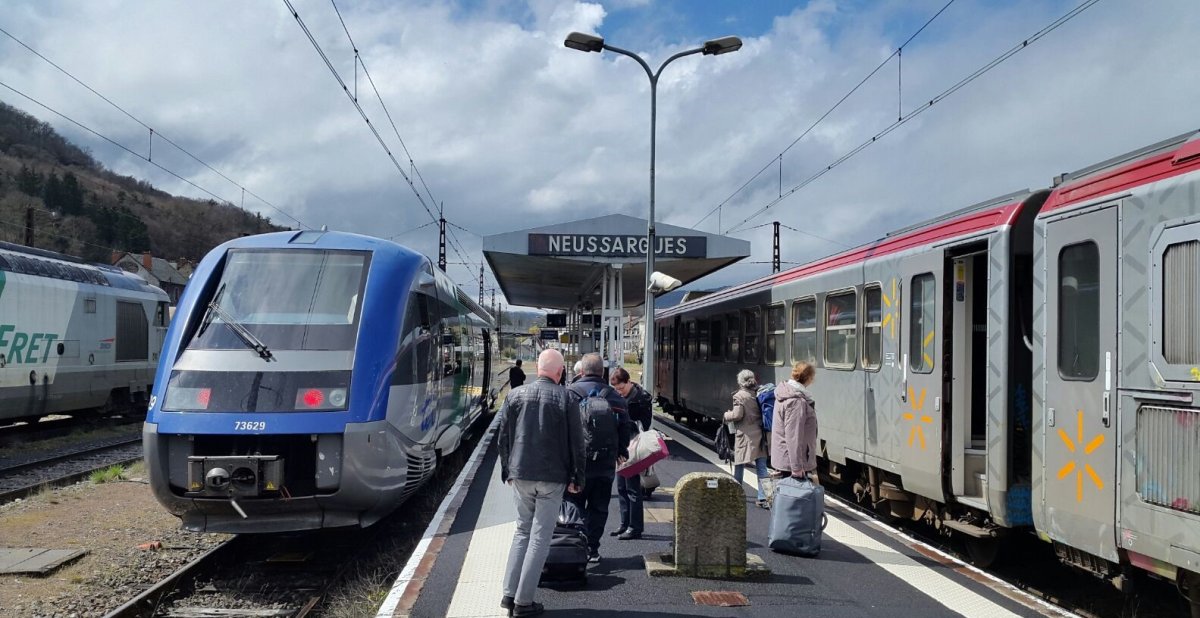
Afternoon at Saujon
Afternoon at SaujonLocated north of the Gironde in Charente-Maritime on the Royan – Angoulême line, Saujon is also the junction with the Train des Mouettes line to La Tremblade.
Opposite. On 6 September T Henschel & Sohn 030T 11128/1912 arrives at Saujon with a train from La Tremblade. Below left. B 84811/12 M, the first of 12 Régiolis to be constructed by CAF for Nouvelle-Aquitaine, arrives at Saujon with TER 864512 13.29 Royan – Angoulême. Below right. B 81681/82 passes with TER 864544 12.49 Angoulême – Royan. Photos: Georges Turpin.
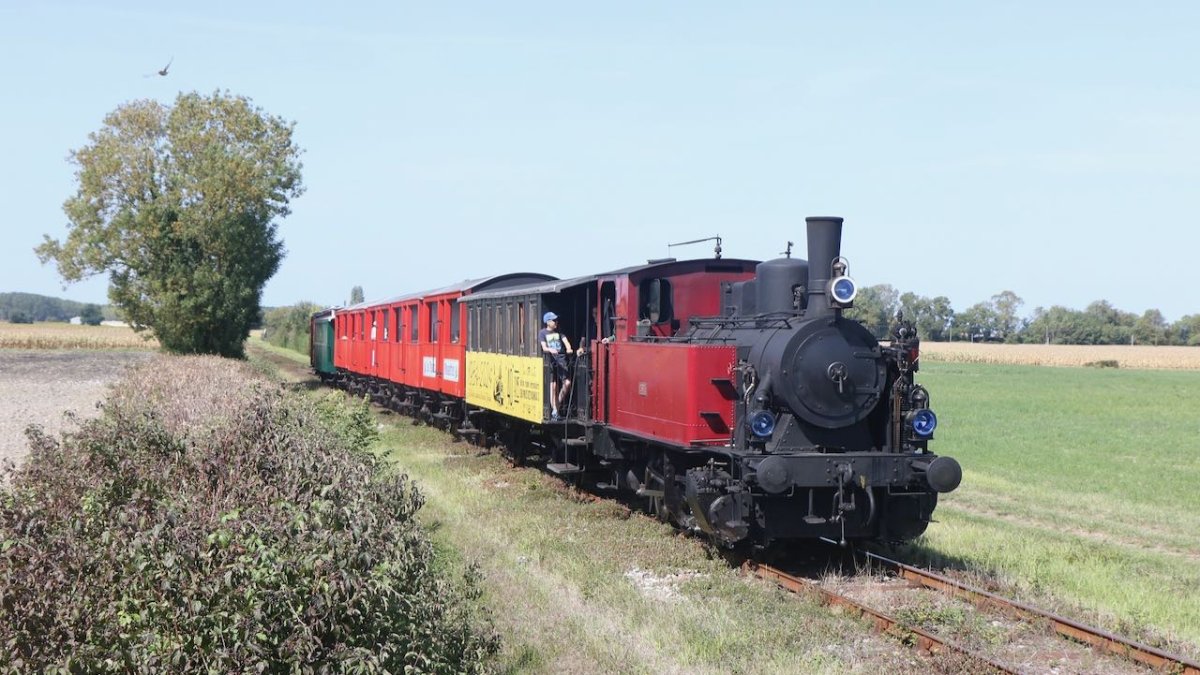
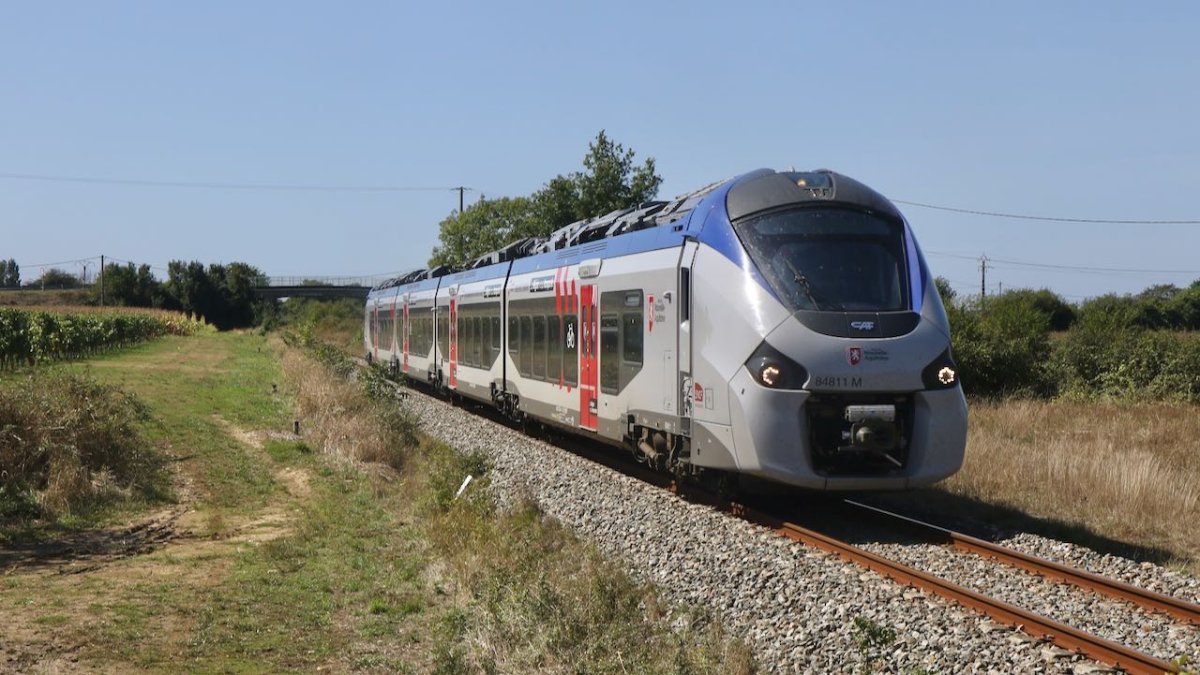
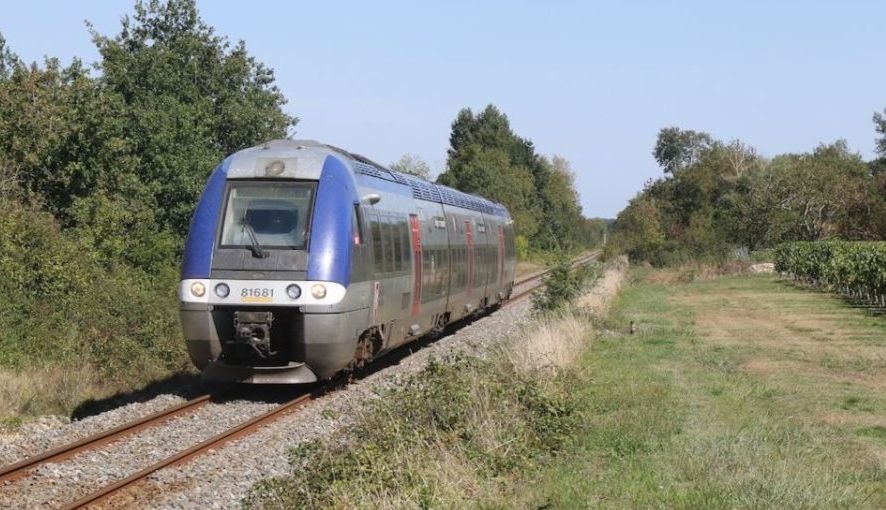
Turning back the clock
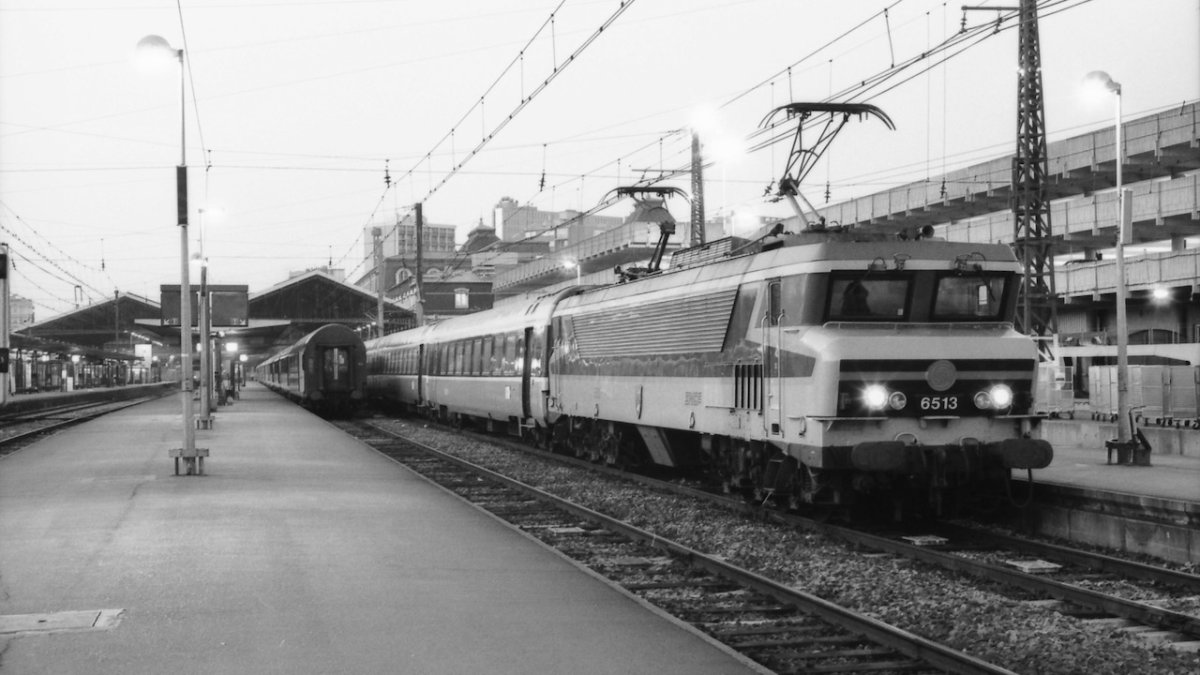
The end of September saw two anniversaries. On the 24th it was the 50th anniversary of the last steam working in France (other than in preservation), with 140 C 287 operating a freight between Troyes and Sainte-Colombe. A day earlier, the 23rd was the 30th anniversary of the final working of Le Capitole from Toulouse to Paris, seen above departing from Toulouse Matabiau, the dark red Grand Confort coaches hauled by CC 6513. Photo: Georges Turpin
In 1969 the journey time was 6h exactly in both directions, with calls at Montauban, Cahors, Brive and Limoges. The early 1970s saw the sharpest timing, 5h 56min from Paris to Toulouse. At that time, 200km/h (124mile/h) had just been authorised between Guillerval and Cercottes (46km), in addition to the route between the Loire Bridge in Orléans (PK 125) and the entrance to the Alouette Tunnel (PK 195) just before Vierzon, which had been in operation since 1967. Another improvement at the same time was the switch to 100km/h (62mile/h) at Vierzon station instead of the previous 30km/h (18mile/h). By the 1990s the timing had been eased to 6h 18 to improve reliability, compared to timings of between seven and eight hours today, although with many more stops. Sadly, the prestigious Grand Confort coaches could not compete with the rapid growth in air travel between Orly and Toulouse and the coming of TGV; Le Capitole was replaced by a slower Corail service calling at more stations.
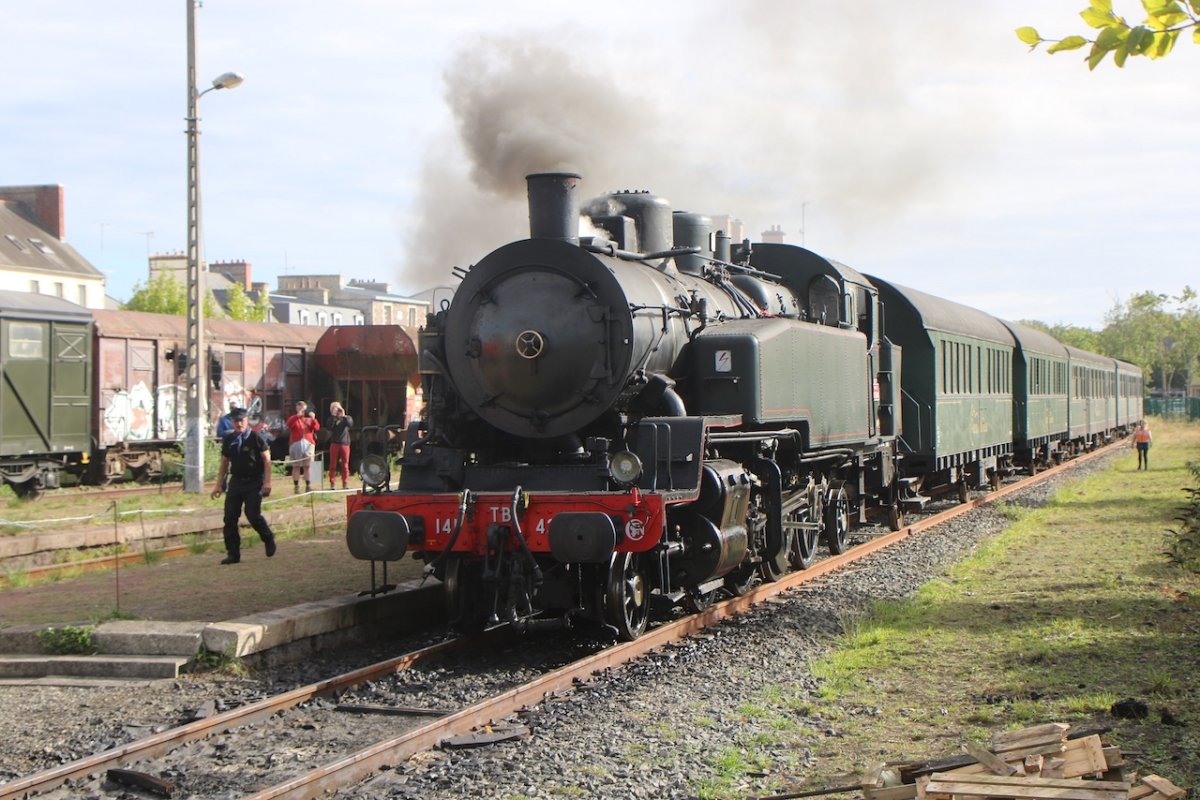
The Vapeur du Trieux had a chequered season this year following the lengthy overhaul of 141 TB 424. Certification of the locomotive and rolling stock took longer than anticipated, causing a delayed start to the season. This was then followed by problems with poor-quality coal that led to services being suspended for a week. The final run took place on 31 August, seen above waiting to leave Paimpol for Pontrieux. The loco and stock returned to Carhaix on the 2 September with a diesel pilot. Photo: Georges Turpin.
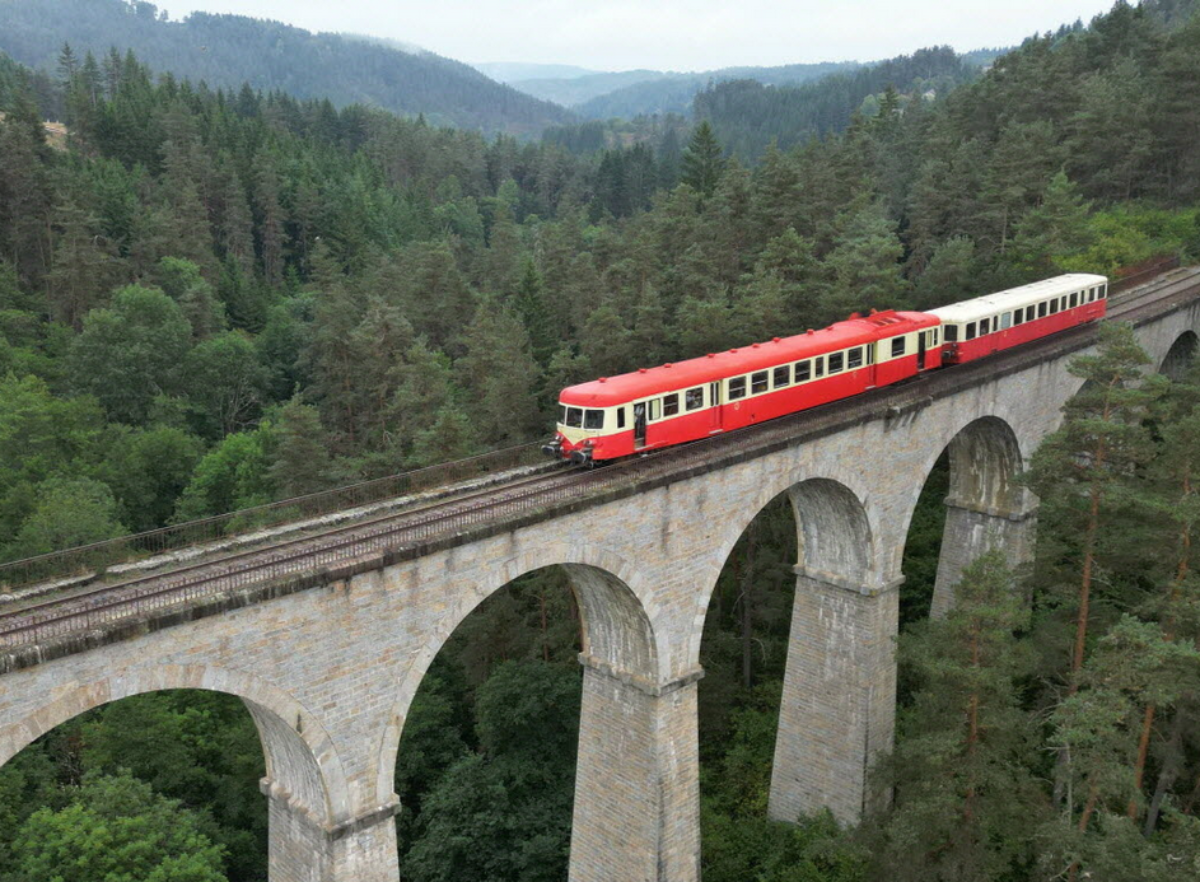
CF du Haut-Forez. After a four-year break whilst defective track was renewed, CF du Haut-Forez resumed operations on 1 August over the La Chaise-Dieu to Estivareilles portion of the Livradois-Forez Railway. On 26 August, X 2807 and trailer XR 8236 are seen on Pontempeyrat viaduct, 36m above the Ance river at the boundary between Loire and Haute-Loire départements. Photo: Le Progrès/CJ.
On the occasion of the Journées du patrimoine weekend, the pair ran a special from Estivareilles (10.30) to La Chaise-Dieu, returning at 17.00; fare €5 instead of the usual €19. The President of the CFHF Association was on board and at La Chaise-Dieu made a speech reflecting on the track repairs and in particular sleeper replacement that had been carried out, thanking Haute-Loire département and the various communes en route for their financial contributions. At La Chaise-Dieu in the afternoon, Agrivap Panoramique X 4208 arrived from Ambert on the last regular Sunday working of the season.
Below. X 2807 and trailer at Sembadel on 21 September, to the left is a recently-restored PLM cloche d'annonce, and later seen heading through the misty forest on the return from La Chaise-Dieu. Photos: Roger Allen.
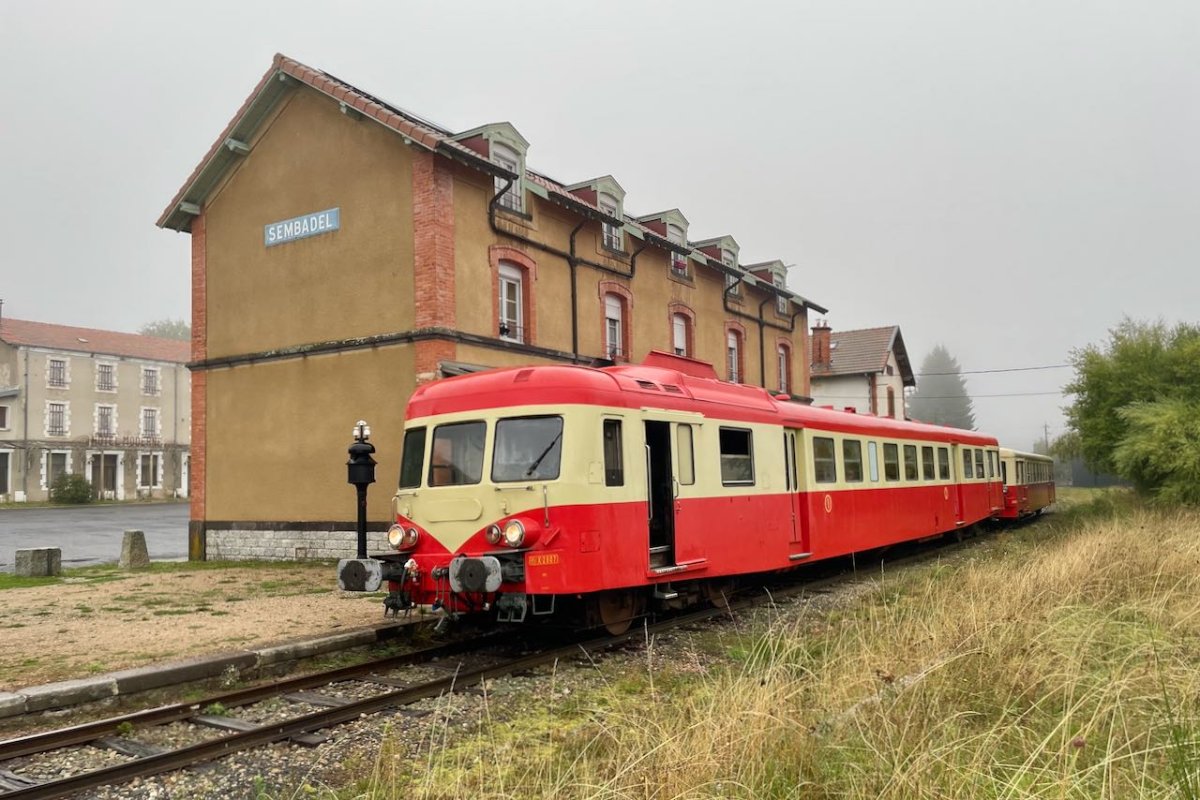
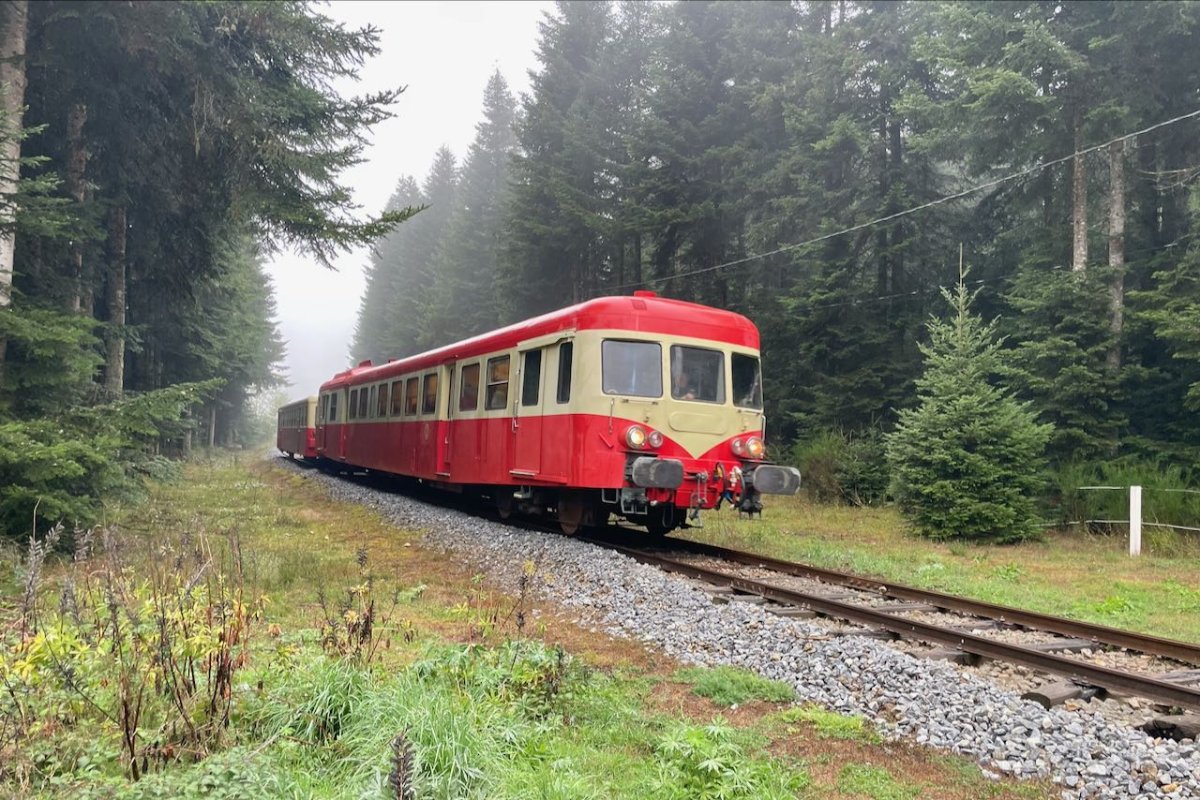
Jinxed. For the third successive summer, the Tramway Touristique de la Vallée de la Deûle (Amitram), near Lille, has been unable to operate. Another cable theft in early-June wiped out all the winter’s work on restoration of the overhead and put paid to the summer season.
Réunion Express revived
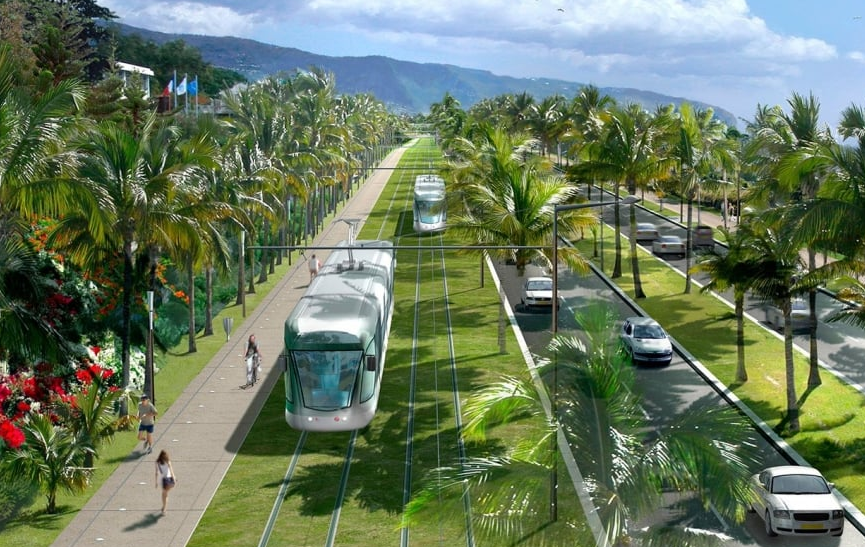
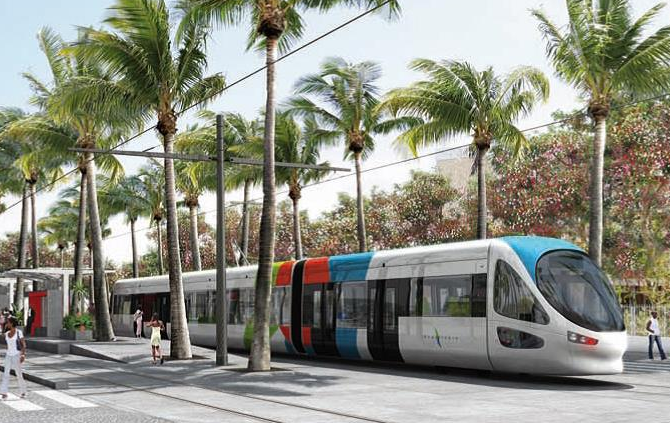
The Département Outre-mer of La Réunion (in the Indian Ocean) and its five municipalities have signed a ‘partnership roadmap’ for revival of the Réunion Express interurban railway along with bus and road improvements designed to reduce dependency on private cars and cut carbon emissions. The planned route is that of the tram-train project abandoned in 2010, linking towns along the west and north coast. It would be built in two phases as before, following completion in 2030 of the New Coastal Road currently under construction along the littoral. A Société locale des Grands Projets is to be set up to take the project forward and seek funding for the estimated expenditure of €2.2 billion. Studies will be made over the next two years, with opening unlikely before 2035.
Little information was given on the railway’s technical specification though it is likely to be an updated version of the previous project and will utilise the preliminary works carried out in 2009. This was a 140km single electrified standard-gauge line with 26 stations, to be served by a fleet of 30 tram-trains capable of up to 110km/h outside urban areas. The 40m-long cars were to run every 10min at peak times, with annual patronage estimated at 15 million. Larger stations would be intermodal hubs with buses linking inland settlements.
Phase 1 was to link Saint-Paul with the capital Saint-Denis and its airport (41.5km), of which 12.5km along the north coast was to be in tunnel. Finance of €435 million had been secured and a contract awarded, but following a change of government in 2010 the money was diverted to reconstruction of the coast road. Another attempt was made in 2018, when a 9km link from Saint-Denis to the airport also failed to get off the ground. Images from the prospectus of the project abandoned in 2010: Réunionnais du Monde.
Urban Rail
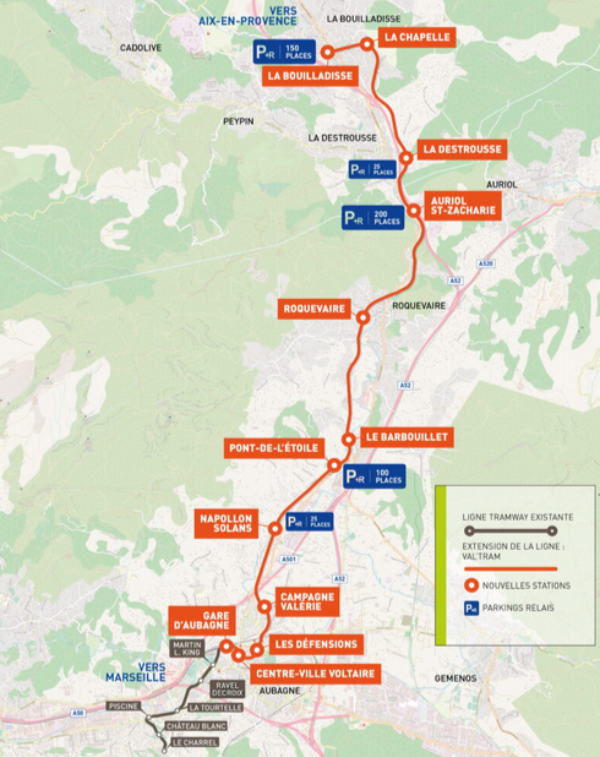
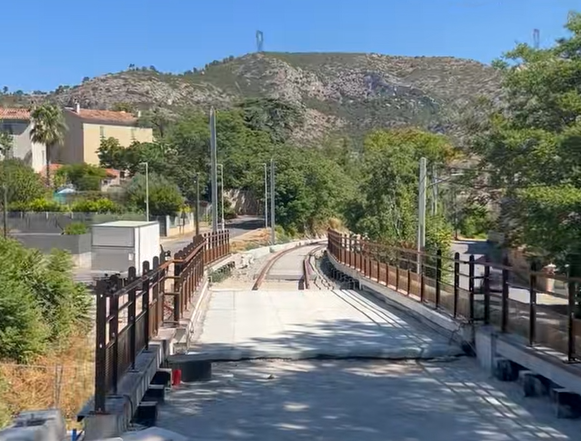
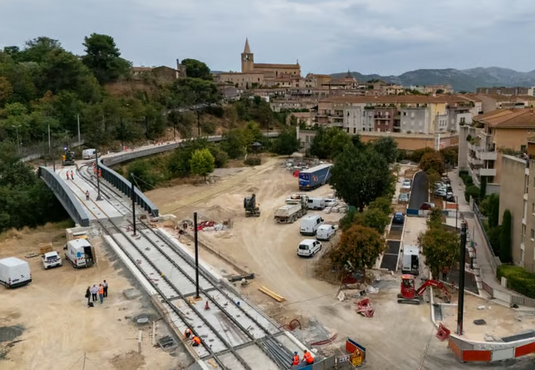
Val’Tram. Tracklaying between Aubagne and Bouilladisse is nearing completion, to be followed by four months of trial running prior to opening next spring. The 13.2km Val’Tram utilises the alignment of the Aubagne – Valdonne line, closed to passengers in 1939 and freight in 1987. It is intended to relieve heavy traffic on the RD96 road, used by 18,000 cars daily. Photos: La Provence/GB.
Toulouse. Welding of rail for Line C started on 29 August at the future Daturas maintenance depot. The first lengths will be laid at Labège by the end of the year.
Toulouse. Welding of rail for Line C started on 29 August at the future Daturas maintenance depot. The first lengths will be laid at Labège by the end of the year.
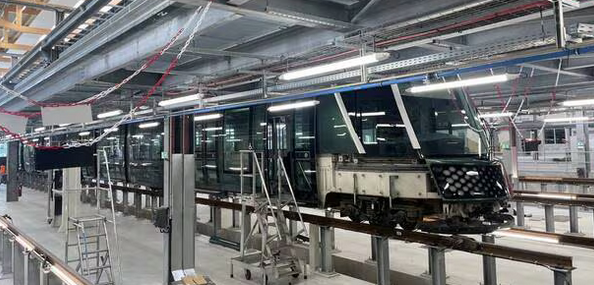
Nantes. The Cetex tram maintenance depot at Babinière opened on 25 August, said to be the largest in France, built at a cost of €143 million. Naolib’s 61 long trams operating on Line 1 are based here, and heavy maintenance will be carried out on the entire fleet. Photo: Ouest-France.
Strasbourg. With two months to go before opening in mid-November, trial running on the 4km Line F Tramway Ouest extension to Wolfisheim started on 9 September.
Triangle de Gonesse. Construction of a station here on GPE Line 17 continues to divide opinion since cancellation in 2020 of the EuropaCity retail and recreational development which it would have served. Slated as a station ‘in the middle of open country’, the site between Le Bourget and CDG airports is being developed with a college campus for 2,300 students and the national centre for Arts de la Rue opening in 2027. This section of Line 17 is expected to open in 2028.
Ferney-Voltaire. Work has started in Switzerland on the 5.5km Tram des Nations, the future Line 13 running from Place des Nations in Geneva over the border to Ferney-Voltaire. On opening in 2028, trams will link the French suburb to central Geneva and Cornavin station in 24min. There will be three stops on the short French section, and a 500-vehicle park-and-ride at the Bisou terminus.
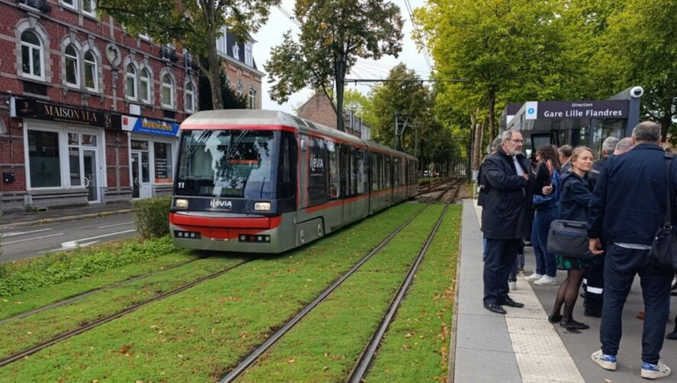
Lille. The rentrée started badly for Lille’s beleaguered metro Line 1, disrupted during the first few days of September by heavy rain and periods of closure due to failure of the control system. However, the big test over the Braderie weekend on 6/7 September, when trains ran all night to move many thousands of visitors thronging the street markets and entertainment venues, passed off without incident.
Renovation of tram stops and greening of the Mongy’s tracks over the past three summers was completed on 31 August at a cost of €60 million.
Additions to FRS Photographic Archive during August & September 2025
To Photographic section
- Images of Jacques Poré’s visit to TTVA @ Arques to Folder 1
- Colour images from the FRSC have been added to their gallery in Folder 1
- LVDR Hors Serie 1964 - SNCF in WW2
- LVDR 1416/Sept 1973 - Maurienne
- LVDR 2114/Oct 1987 - Bordeaux
- LVDR 827/Dec 1961 - Ariège
- LVDR 1211/Sept 1969 - Eiffel’s viaducts
- LVDR 1850/July 1982 - Causses
Additions to the FRS public folder during August & September 2025
- Two builders’ catalogues of Messrs Couillet, Belgium
- CdF du Nord Timetable Ete 1893 “Bains de Mer”
- PO Midi July 1936 and SNCF Chaix Summer 1969 timetables
- Thirteen timetables provided by David Haydock
© Peter Lovell & Chris Bushell. The French Railways Society 2025. With thanks to Georges Turpin, Christophe Masse, David Thirlwall, Martin Barnsdall, Gareth David, Jean-Pierre Fiers, Pierre Julien, Jean-Louis Poggi and Roger Allen.
